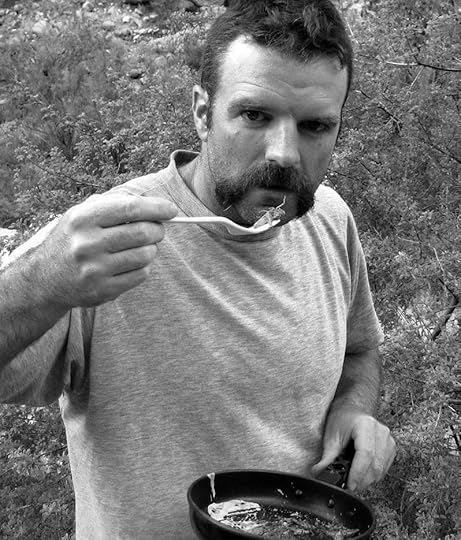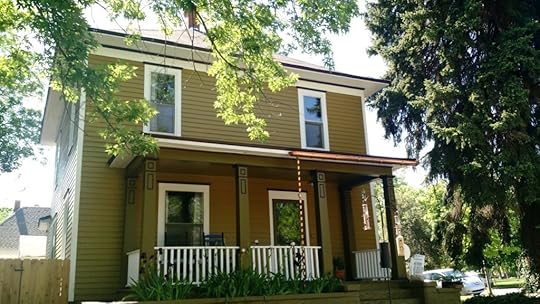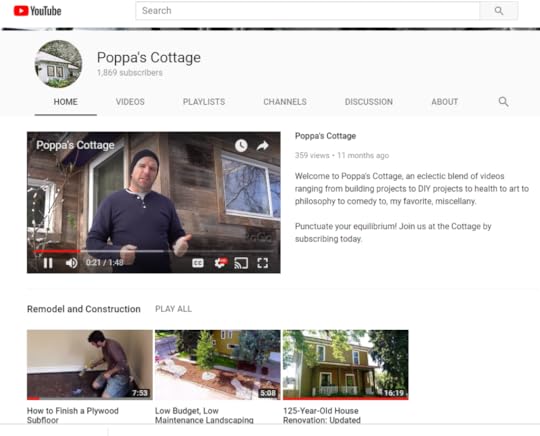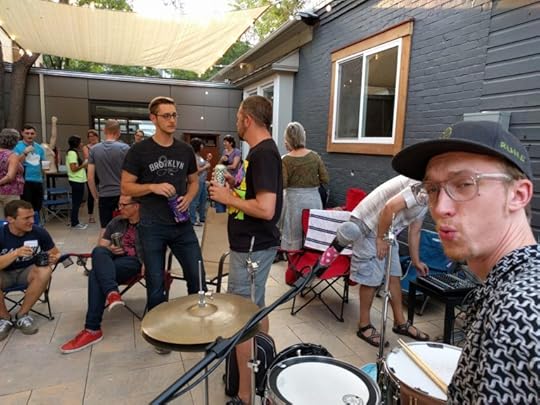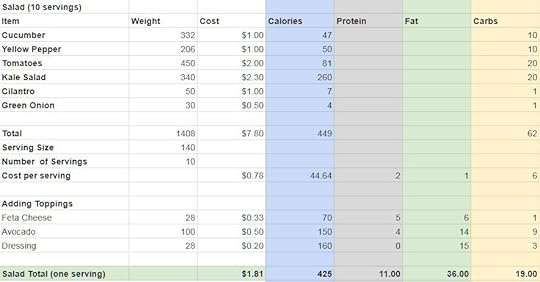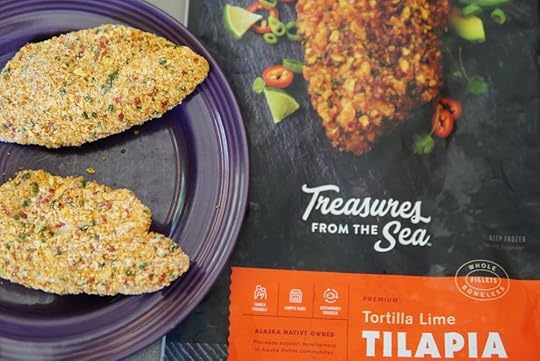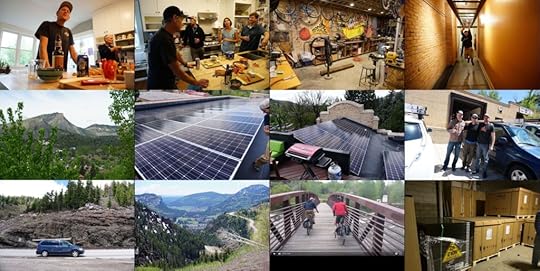Mr. Money Mustache's Blog, page 6
November 8, 2018
An Interview With The Man Who Never Needed a Real Job
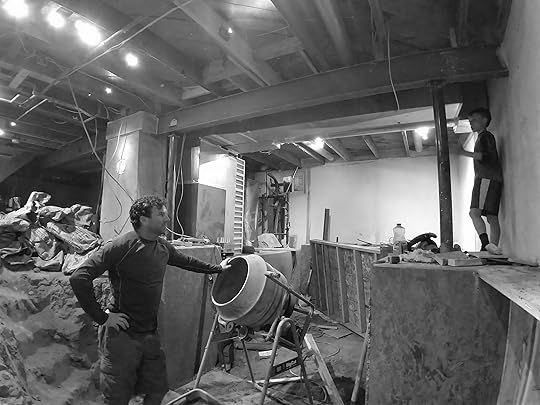
I’d like to retire soon. I’ve had a good career and the numbers say I’m just over the threshold, but I’m still afraid.
It would help if I had a solid plan for what to do after retirement – perhaps even make some money eventually. Because I think it would help boost my confidence to pull the plug at the old law office. But as an attorney, I’m trained to see the pitfalls of everything and frankly I’m afraid.
How do all of you fearless Mustachians just go out and start businesses and make money, when it is so hard to get started – so many details and contingencies to account for?
– the Skittish Scottsdale Solicitor
Dear SSS,
To answer a question like yours, it sometimes helps to look at a role model who has some of the traits you would like to cultivate in yourself. So this seems like the perfect time to share a story I have been wanting to tell here on MMM for at least five years. And the funny part about this tale is that it keeps getting more interesting, the longer I wait to share it.
It is the story of my long-time friend Luc, who has earned a reputation in our own community as the honey badger of entrepreneurship.
The Honey Badger
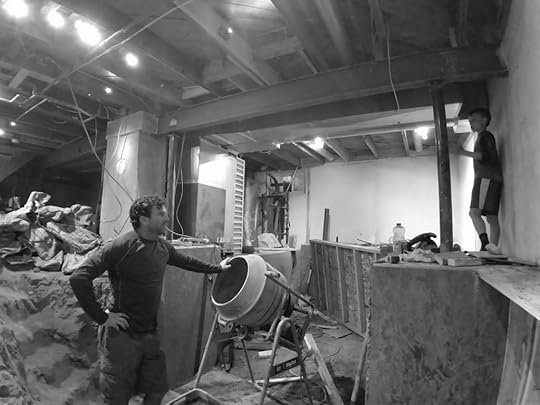
Luc takes a brief rest from digging out 30 tons of dirt from his own basement and hand-pouring a new foundation while his son supervises.
From painting houses to raising edible insects, selling handmade pine coffins to writing and shooting his own feature length film in Scotland, all while never becoming too proud to take a literal Shit Shower while cleaning the sewer lines in his own rental properties, Luc’s story never fails to amaze. And it can be especially useful for those of us on the other end of the spectrum – wannabe entrepreneurs who are still hesitating to open our first small business checking account.
This story is a great financial lesson as well. Luc’s family* has gone from zero to financial independence without the benefit of the easy tech salaries that got my own household there back in the mid 2000s. Like most of us, they have seen windfalls and setbacks over the years, but the biggest factor in getting them to a better financial place has been continuing to get the work done, while choosing not to squander all of the proceeds on an ever bigger lifestyle.
So from this interview I’m hoping you will pick up both some inspiration for continued down-to-earth hard work, and a perspective to just go out and try new things, especially in the area of entrepreneurship.
If you do it right, there is upside waiting around every corner. So let’s get into the questions!
The Man Who Never Got a Real Job
MMM: The first moment we met was in July 2005, when I had just retired and we bought our first house in old-town Longmont, with a baby on the way. Walking through my new backyard, I immediately noticed two thirtysomething dudes in dirty clothes, working up on the roof of the old garage on your side of the fence. And I thought to myself, “These are my type of people!”, and walked over to meet you.
What was going on in your life at that moment, in both life and business?
Luc: Well, considering our daughter was born nine months later, it was near the end of one phase and the beginning of the next. At the time, my primary business was a house painting company that I had started in the late ‘90s, after my biology degree wasn’t enough to get me a job at a pet store (in Boulder you need advanced degrees for that sort of thing).
I had worked pretty hard to get that painting company up and running, starting as a one-man show, then employing as many as 18 people at one point. It was a good gig in that I had a lot of free time to work on other projects in the winters, and even went back and got my Master’s degree along the way.
By 2005, though, I had severely downsized the company and I was back to a small crew. I was beginning to think about what I wanted to be when I grew up.
One project we started that year was buying and quickly fixing up a house a few blocks from our place on a street called Carolina Avenue. This was primarily achieved by leveraging the equity we had built up in our first house. I still own and rent out that place (which you subsequently helped me do a more extensive renovation on).
MMM: So then we both had these children born at almost the same time, and all six people in our two families became friends. We both started helping each other with construction projects, but when Longmont denied my building permit application to expand our tiny 600 square foot house, I decided to move out and turn that one into a rental, and move into a bigger place a few blocks away. What was the catalyst that made you leave the little leafy paradise of that street? (and yes I realize this is a leading question :-))
Luc: The first thing is that old Happy Street is a pretty busy street, and with a young daughter, we thought it might be nice to live on a quieter stretch. One day my wife and I went for a walk and picked our favorite blocks in the neighborhood. There happened to be a “beautiful” old fixer upper for sale on one of those blocks, and within a few days we were under contract.
That we were willing to take the plunge so quickly was largely because of you and your construction company. At the time, I hadn’t done any extensive remodels, but because you were willing to help me out, I figured we could make it work.
At the time, my wife was certain that it would be a fix-and-flip and there was no way she would actually live in the house. Because it started out in such bad shape, it was hard to imagine it ever becoming a nice family home, but it really did in the end. So we we moved in at the beginning of 2008 and here I sit, typing away in the office.
The Rental Real Estate Projects
MMM: So, our biggest collaborations over the years have been in fixing up houses, often rental houses that one of us owned (okay most of them were yours.) We started with The Foreclosure Project in 2011, then went back and did a major upgrade to one of your other places here in town. Most recently we did The Atwood Project, which was the inspiration for my post on Installing your own furnace.
How has your experience been in owning single family rental houses, while doing your own management and maintenance? Is it a reasonable return on your investment and labor?
Luc: There are a lot of real estate/rental experts in the Mustachian fold – I am not one of them, but real estate is the main reason we’re now financially independent.
We bought our first house in 1999 with $5000 from my dad and a $3000 courtesy check from Chase. We chose the house because it had a mother-in-law basement, with its own entry and kitchen – we went from paying over $900/mo in rent to having a tenant and paying around $300/mo toward our own house. We were fortunate enough that soon thereafter Longmont housing prices had a nice little bounce.
In 2003 I took out a home equity line of credit and we bought a condo in Fort Collins. A realtor soccer friend had given me a handy little spreadsheet that detailed all the ways to make money from real estate, and at the time it was hard to find cash flow properties in Longmont.
In hindsight, that first condo was a mistake. It was an hour commute to deal with any issues, it wasn’t a place I had much emotional attachment to, and it didn’t attract tenants who cared about it – it was a soulless investment. Nonetheless, we held it for over ten years, and finally saw some significant appreciation in the last few years (and it gave me my first taste of YouTube success with a video on How To Finish a Subfloor.)
I sold the condominium on Craigslist in 2015 and did a 1031 exchange for the Atwood Project – probably the most soulful investment I’ve made.
The lesson I learned from that first condo was that I wanted properties that were in my neighborhood, that I cared about, and that, when fixed up, made our community nicer. And of course they had to make money, too. Again, I was lucky enough that all those things were achievable here in Old Town Longmont, even through the recession.
Over the years, we leveraged our way into four rental properties in Old Town (moving into our current place along the way and turning that original home into a two-unit rental). The cash flow alone allowed me to spend less time painting and more on other pursuits. And my wife was able to move her teaching career down to half-time.
In 2016, I spent an average of under 10 hours per property – over the whole year – on maintenance and administration. Yes, there are occasional shit showers when cleaning out an old lead P trap, but most of it is more pleasant than that.
After finishing up the remodel work on the fourth and final property, we had 100% occupancy in all places and pulled in about $92,000 in rent; $36,000 after expenses.
Meanwhile, our longer term gamble on the livability of Old Town has paid off, as home prices have more than doubled here in the last several years, leaving us with equity close to $1.5 million (including the home we live in). The best example is the Foreclosure Project, which we bought for $113,500 in 2011, put about $25K into it, and is now worth over $300K.
To take some of that appreciation money off of the table, I chose to sell the most expensive of these houses last year, and re-invest the cash into standard stock market investments.
This is where MMM will probably caution you that not all real estate investment will go so well.
Building DIY Electric Cars
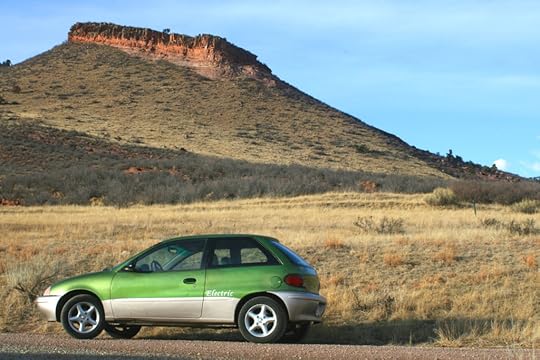
Although it’s no Tesla, this little homemade contraption was my first peek at the world of electric cars.
MMM: One of the most technically impressive things to me, was the time you read a book on converting an old gas-powered GEO Metro econobox car into an electric vehicle (EV), using basically a trunkload of golf cart batteries. And then decided to team up with a friend and try the same thing yourselves.
Not being auto mechanics yourselves, what possessed you to do this? And did it turn out to be a good business idea in the end?
Luc: Ha, this was a terrible business idea. I can remember sitting in the office of the City of Longmont fleet manager, trying to convince him to let us convert some of their gas pickups to electric; Fox News was blaring in the background and he was staring daggers at me. Needless to say, we didn’t get that gig, and that was probably a good thing, considering we didn’t have the expertise or capital to pull off truly decent EV conversions.
We did do a couple GEO conversions and an old Ford pickup, which was a lot of fun, but they were novelties more than anything. That was 2009, and it was an exciting time in the electric vehicle world. Lithium batteries were becoming more reliable and less expensive, the movie Who Killed The Electric Car? had come out a few years prior, Tesla was starting to make some waves, and of course addressing climate change was becoming more urgent. I wanted to do something meaningful, and I thought electric cars were the future of transportation. The cash flow I was getting from rentals had given me more free time. And I’m slightly crazy, so why not start an EV business?
At the time, Colorado had an amazing incentive for people to buy EVs. One of my favorite parts was arguing with the clueless administrator of the law for months, and then lobbying for sensible changes and clarification when they wrote the new law.
We spun off a new company, Boulder Hybrid Conversions, with two other guys (with more EV expertise), in which we converted Priuses to plug-in hybrids by upgrading them to a larger battery.
Meanwhile, largely thanks to my partner, our original business morphed from being a handcrafted car conversion hobby, to a reseller of electric car batteries and other components. It became one of the larger businesses of this type in the country, grossing over $1 million a year. I had a lot of other ideas for how we could expand the business, but my partner didn’t see it, so he ended up buying me out for about $125,000 (which, for all the time I put into the biz, turned out to be decent but not extravagant hourly compensation).
Boulder Hybrid Conversions became Boulder Hybrids, specializing in hybrid and EV maintenance and repair. One partner bought the rest of us out, and he continues to grow that business. I now own a 2013 Nissan Leaf and a 2015 Prius wagon (my off-road vehicle) and one share of Tesla, and I look forward to the day when I can buy an autonomous mini-van that will safely transport my family and me to Wisconsin overnight while we sleep.
Dead Pine Trees for Dead Bodies
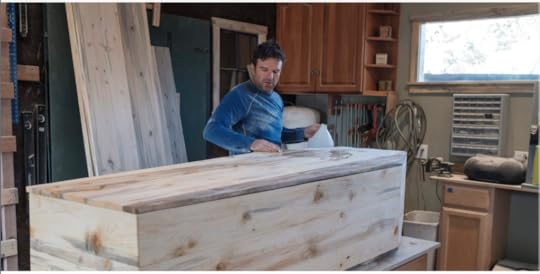
A handcrafted biodegradeable coffin takes shape in the handcrafted workshop. (image credit: Mat Bobby / Longmont Colony)
MMM:
One day, I got an email from you that said, “Well, I’ve done it again – decided to start yet another business. Building coffins from reclaimed beetle-killed pine planks”
So we both reviewed the simple plans from a book you had found in the library, built a prototype of this Dracula-style “toe pincher” coffin, and then you photographed it and put up a website. I gladly worked alongside you because I like hanging out and building things, but I remember thinking, “Luc’s really gone off the deep end here – who is going to buy our DIY coffins??”
What was the motivation and the eventual fate of that coffin venture?
Luc: I started Nature’s Casket in 2009 for the same reasons I started the EV business: to do something meaningful for the environment. And because it was different and exciting. And because I wanted to help my brother with more hours when we had downtime from painting. All the remodel work we had done meant I had most of the woodworking equipment I needed to build coffins. And it was nice to have some technical, logistical, and, hell, labor support from old MMM to get it going.
The green burial movement, already well-established in the U.K., had been growing in the U.S., largely as a result of the Ramsey Creek Preserve, a conservation burial ground that conserves the land in a natural state. Green burial is traditional burial: simple and environmentally friendly (none of the swimming pools full of formaldehyde that are pumped into cadavers, no unsustainably harvested wood, stamped metal caskets, toxic paints, concrete vaults, or pesticides and copious water for manicured cemeteries).
Here in Colorado, the pine beetle epidemic was devastating our lodgepole pine forests, but leaving a lot of dead trees with beautiful blue grain (from a fungus that feeds on the beetle’s waste).
With some support from Karen Van Vuuren, who runs a nonprofit helping families direct their own funerals (and has now started The Natural Funeral), I was able to start getting the word out and selling a few caskets here and there. And it turns out that the media is really interested in things like death and beetlekill wood.
The Denver Post ran a front page article on my business in 2010 – many people saved that article, and when they’re ready, I get a call for a casket (to this day I’m still getting calls from that article). The New York Times mentioned Nature’s Casket (they never contacted me, so my mom was the first one to tell me about that). The Wall Street Journal sent a guy out to do a piece on beetle kill (I wasn’t mentioned in the article, but had a lot of time in the accompanying video). National Geographic sent one of their photographers out to take photos of the caskets at a funeral, but we didn’t make the magazine. There was also a nice story in Longmont’s Times Call newspaper.
Soon I was shipping coffins around the country. One of the most interesting gigs was when we built and reinforced eleven oversized caskets (with MMM on welding and metalworking support) that could hold up to a ton; these were for the reinterment of a 19th Century family cemetery in Virginia that was being moved to make room for a high school football stadium (most of the remains were biodegraded, so they included all the dirt from each plot).
This is where I should mention that I’m kind of success-averse. Nature’s Casket could have been a large business with an industrial shop and a storage warehouse if I had pursued that path. Instead I stopped shipping (too onerous and stressful) and ceased most advertising. Now it’s just a local business, and I average less than one casket a month – it’s still quite rewarding, but there are other projects to focus on.
Miscellaneous Mini Businesses and Pursuits

MMM:
Scattered in among these years were a few smaller things. The time you started designing your own greeting cards and printing them on fancy textured recycled paper. Then there was Simple Brew Kits, which was just assembling the required components for converting good grocery store cider into booze. A photography pursuit that started with just taking your daughter to over twenty of Longmont beautiful parks and ended up culminating in a show at the city’s museum.
Oh! And then of course the time you went to Scotland with two friends and some quickly researched photo equipment and shot a feature length film that ended up in the Front Range Film Festival – despite the fact that none of you had any experience or training in filmmaking. What was that all about?
Luc: Recycled Greeting Cards was actually born in the late ‘90s, around the time I started the painting biz. At one point I had pretty high hopes for RGC, even attending the National Stationery Exhibit in New York. That business was mostly a failure, although I have one loyal business customer who still buys a thousand or so cards a year.
Simple Brew Kits was a business I started for a blog post that I never published titled “How To Start A Business In One Day.” And that’s essentially what I did, filling out all the paperwork and putting up the website in a day. I didn’t sell many, though, until your post about the business, after which I was suddenly inundated with hundreds of orders. That slowly tapered off, and recently I decided to shut it down for good. Again my success aversion won the day. But we made a lot of fun (and some disgusting) drinks out of that whole deal, and I’ll still occasionally bust out some fermented cider or grape juice.
The photography gig was a byproduct of becoming a parent. My daughter was born in the spring of 2006. After my wife’s maternity leave, I became a stay-at-home dad off and on for a couple years. I wanted a project that would get us outside, but that would also provide me with something exciting. I decided we would visit each one of Longmont’s city parks and take pictures. I just had a little point-and-click dealio, but it took decent pictures.
A few years and thousands of pictures later, I chose one photo from each park and submitted the project to the Longmont Museum. To my surprise, they accepted the show, and even helped me publish a book of the photos. It was a gratifying experience and has led to more photography projects – something I’ll continue to pursue.
The Scotland film, Carve The Runes, came from an idea I had many years ago to get a group of friends together, rent a castle in Scotland, and produce a music album (despite having no musical talent). Over time, the idea morphed into making a film instead. I was able to convince my brother Isaac and a good friend, Ian, that this was in fact a realistic and good idea.
And so, in 2015, we spent ten days traveling around Scotland, filming and, well, just filming – we didn’t have time for anything else. I had envisioned some time for fly fishing and golfing in between shoots, but damn, making a movie is hard.
The film is about two brothers, one of whom has a terminal illness and goes to visit his brother in Scotland, where he’s doing climate change-related research. The basic idea for the film was laid out beforehand, but most of the script was written on the fly (I didn’t think we would use a script). Ian was cinematographer/sound guy/key grip/best boy, and maybe more important, moral support. We didn’t sleep much, and we drank a lot of scotch. It took us a couple years, but we finally finished post-production at the beginning of 2018.
We submitted it to a number of film festivals, and were happy to be accepted into our local Front Range Film Festival, where we won Best Feature (out of a limited selection). The acting and cinematography are suspect, but the soundtrack (friends and acquaintances) and screenplay, if I may say so, are legit; I’d love it if we could remake this with some real producers and actors (Francos, Afflecks, are you reading this? Or maybe the leads should be sisters).
A Quixotic Urban Oasis and the Big Dig
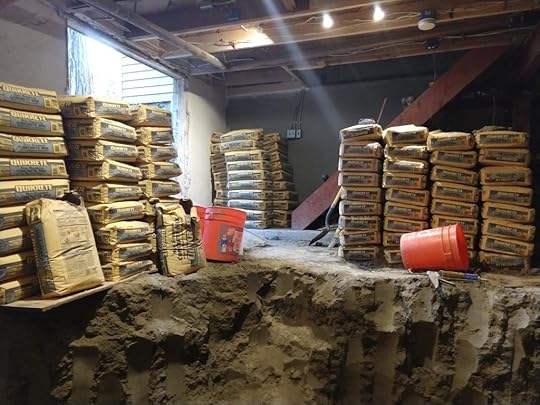
A few thousand pounds of concrete? all in a morning’s work.
MMM:
Surely the most concentrated demonstrations of your varied efforts and interests is in your own house. Because we restored it together from its original tippy skeleton into a solid and classy residence. But then a few years later went on to add a two story addition all the way up from the hand-dug structural piers. And then to build the garage workshop which has turned into an enviable hobbit-like enclave of living and productivity, both inside and out.
But all of this pales in comparison to the most recent upgrade, the Big Dig where you hand-dug about 60,000 pounds of concrete and soil out of your own basement (with occasional help from a beer-fueled team of other local Dads) to upgrade it from the typical Victorian house storage cellar into a very functional Man Cave complete with golf simulator and workout room.
What has driven you to go so far, when some people won’t even change a furnace filter? Any downsides and pitfalls?
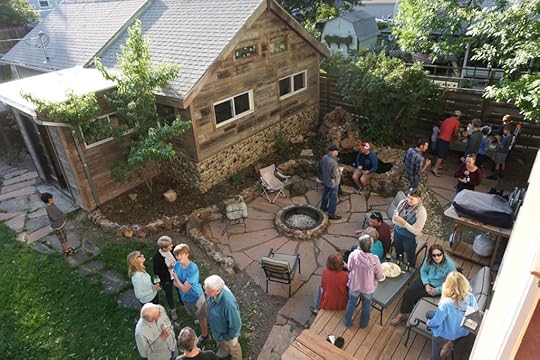
Luc’s Hobbit-esque backyard oasis and workshop/garage, carved from an area that was originally just weeds and concrete.
Luc: I have labeled myself an eclectic: someone who loves to continually explore new ideas and embark on new adventures. The peril is getting so wrapped up in the novelty component that one never finishes anything – what I call dilettantism. This is part of my success aversion: I love to get a project or a business up and running, but it’s hard to continue to find it rewarding once it becomes quotidian. Routine is anathema to eclectics. Most of my projects reach a level of fruition that’s satisfactory to me, but I still think I can strike a balance that leaves things more complete.
To use my house as a metaphor, I’ve completed a number of satisfying projects (with a lot of help from people like you (mostly you, in fact)), but in the meantime many of the details have been overlooked: we need a new kitchen faucet, a toilet needs to be re-seated, I could organize the cookware situation better (and oh, by the way, I should probably spend a little more time with the family).
In the mid-aughts, I was working on figuring out what I wanted to be when I grew up – I decided to embrace my eclectic nature. Now in the late teens, I’m realizing I need to fine tune that to incorporate more focus, responsibility, meticulousness and perseverance.
Physical Fitness and Doing Experiments On Yourself
MMM: Another unusual trait I’ve noticed is that you seem to operate in extremes. You can eat a plate of cookies or drink a bottle of wine in one sitting, but then also go for three days straight with zero food during a fast. You’ve tried a variety of 30-day experiments in different eating styles, following them up with weigh-ins and blood tests to see how they affect your good and bad cholesterol counts. You adopted weight training and have stuck with it for many years now.
This is different from my own approach, where I eat roughly the same thing year after year, making only small tweaks – like I lift heavier barbells and eat more carbs if I want to gain weight, and cut out beer and go to bed hungry when I need to lose fat.
Have you noticed anything about the Human body and what makes it function best? Any advice for people who are prone to binging, on getting control of their eating and drinking habits?
Luc: Oscar Wilde, perhaps after bingeing on absinthe, said “Everything in moderation, including moderation.” That was kind of my motto for much of my youth, and it fits well with the eclectic personality. But if you only practice moderation in moderation, I discovered, you tend to feel like shit a lot and you weigh about 20 pounds more than you should. I’ve modified the motto to Everything in moderation, including gluttony.
I think everybody’s different in terms of what works best for them to stay in shape and feel healthy, but there are some common threads. In our simple carb-y society, one of the easiest ways to eat better is to cut out most simple carbs (but, if you’re like me, allow yourself an occasional plate of cookies).
After all my fasting and intermittent fasting and super low fat and super low carb and alcohol temperance experimenting (and reading the research), I’ve come to a few fairly simple conclusions. First, a low glycemic diet (like the Mediterranean diet) seems to be the best. And eating within a fairly small window each day, say from noon to 6, is healthy. Of course, less alcohol on a daily basis is good.
With the new gym, I plan to have a regular but varied workout that includes weightlifting and short bursts of intense cardio on the bike. And, for eclectics like me, mixing it up and allowing myself to occasionally break the rules is key to continued success.
The YouTube Channel and Online Pursuits
At some point, I remember you started documenting your projects on YouTube. This has grown into a bit of a “channel” where at least one of your videos has over 100,000 views.
I have always hesitated to put up videos myself, because so much of YouTube is slickly produced and well-edited today and I am shy to put up my amateur work – much like the fearful theme that started us off on this whole article today. But you didn’t seem to care, and you just did it, and now the channel is out there.
How has your YouTubing experience been and do you have advice for anyone else? How hard would it be for a YT channel to become a successful business?
Luc: Ha ha, yes, the YouTube project has been quite an adventure. Currently there are three videos with over 100,000 views, including the Atwood remodel video, with over 750,000 views (you’re in that video – how does it feel to be a rock star?). What’s funny is the Atwood video was really poorly produced, yet it still somehow went semi-viral in the spring of 2017, spiking from an average of about 400 views a day to a peak of 21,000 views. That tapered off over the next year and a half, but I’ve made almost $1500 on that video. I’ve been trying to push the traffic from that vid to an updated and better produced version of the video, with limited success.
Like a lot of my other projects, the YouTube project has been a gung ho endeavor, jumping in with both feet in spite of limited skill and experience. A more well-thought out plan, executed with better focus, may have lead to more success. Then again, it might not have gotten off the ground if I had been too cautious.
In my newly grown up and focused life-phase, I hope to grow the channel into one that attracts more subscribers and maybe even provides enough income to buy more than a meal out on the town every month. Still, I have to keep that eclectic feel – I mean who doesn’t want to see everything from remodel work to creative pumpkin carving to insect eating to casket building to Trump parody to crazy body hair shaving? I have about 30 projects in the can as we speak, just waiting to be edited and uploaded.
(MMM note: did you catch that? Thirty projects we haven’t even mentioned in this article, including the time he tried to earn a Guinness world record by carving a 27 foot “Mustache” into his own body hair?)
The best advice I can give to aspiring YouTubers is don’t have a shaky camera – man does that drive people nuts, as I’ve been told again and again by people who watch the original Atwood video (there’s a lot of anger out there, as you well know, MMM). There’s something to be said for the amateur folksiness of YouTube, but there’s a balance between unwatchability and being too slickly produced (I’m still working on finding it). I’m probably the wrong guy to ask about what people want to see, but I imagine it’s pretty much anything you have an interest in, as long as the video is useful or entertaining.
Financial Independence and What’s Next?
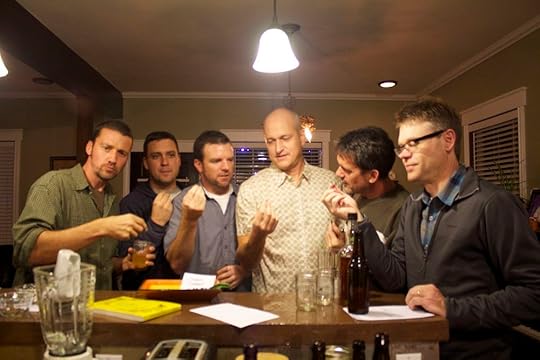
Neighbourhood friends sampling Luc’s Sauteed Crickets at a party
MMM: As the years have gone on, you’ve remained a self-employed person and never stopped working hard on things. But I have noticed your work progressing from hardcore grinding out of professional painting jobs near the beginning, to more eclectic stuff now that is less income oriented. For example, the time you raised edible insects in your basement and researched and wrote an academic paper on how good it would be for the world if we switched some of the rich world’s meat consumption over to nutritionally superior stuff like cricket flour or bee brood. Not a lot of money in that type of thing, at least not to pay this month’s grocery bills.
What has been your secret to this decreased pressure on income making, and would you say you have a better work-life balance now than you had back in 2005?
Luc: Primarily because of my real estate investments, I’m fortunate enough to be in a position where most of my projects don’t need to make money. To me, the end goal in life is fulfillment, and the only way to achieve fulfillment is by making the world a better place, whether through service to the community, producing beautiful works of art, fighting for peace and justice in the world, writing a blog that denounces materialism and promotes sustainable living (wink wink), or just by being a good person to those around you.
A lot of my projects still focus on things that improve my own life, but more and more I hope to work on projects that help others, from the hyperlocal (being a better father and husband and friend) to the local (being more involved in our community) to the global. On the local front, one project you and I have worked on a little together is trying to get more solar power in Longmont. On the global level, I’ve been working with my father, E.G., on The Cooperative Society Project, a decades-long project that looks at the potential for humans to make the transition to a new stage of human interaction: one driven by cooperation rather than conflict.
The way I see it, the beauty of financial independence isn’t freedom from work, it’s the freedom to work on a fulfilling life.
An Afterword from MMM:
So this is a long article. What does it have to do with YOU and your own financial independence?
I have wanted to share these tales because they’re a great example of the idea of living with less fear. The neat thing about Luc’s entrepreneurial ventures is that he is willing to do things, even if he’s not skilled or experienced at them. They often don’t pan out, and that’s okay, because it’s okay to fail. In most cases, failure is just a lesson that leaves you further ahead than when you started, with some great stories to show for it too.
But to minimize the damage of failure and maximize the chance of success in entrepreneurship, Luc and I have both noticed a pattern over these thirteen years:
Start Small and Just Sell Something – most failed businesses start with borrowing and risk. Instead, you should find a customer first and get them interested in buying your stuff. Only after the sales come, should you reinvest some of this money into a bigger business.
Hard Work Can Save You from your Mistakes – when you’re getting started in anything, you will make expensive mistakes. But you can dig in harder and correct them and learn from them. You need to be willing to launch the business out of your spare room, be your own janitor, and make late night runs to the supply store or the post office to get those shipments out. Plenty of time for kicking back and gathering passive income later on, once the business is profitable
Keep Life Simple, Frugal and Stay Focused – a business takes time to build and it takes a while for it to start producing money. But if you enjoy it as your source of entertainment, it will naturally get the time it needs: Spend your weekends in the workshop instead of the golf course or the ski hill. And if you let go of material desires, you won’t be nearly as hungry for money. So while a $20,000 per year hobby business won’t even cover the lease payments on your neighbour’s pickup trucks, it may be more than enough to keep you well fed and happy, for life.
If you’ve got a lifestyle business that you love, feel free to share it in the comments beow and inspire the other people reading alongside you.
—
* In this article I profile Luc, but he is of course part of a hardworking and resilient family of four. His wife is also a friend of mine and an equally wonderful person, but I have kept this story just focused on Luc in the interest of the privacy of the rest of the family.
Further Reading:
Poppa’s Cottage YouTube Channel
The Potential For Entomophagy To Address Undernutrition





October 5, 2018
What Everybody Is Getting Wrong About FIRE


Fig 1: Suze Orman’s opinion of our lifestyle, as captured in a crazy interview on Paula Pant’s Afford Anything podcast.
In case you hadn’t already noticed it in the news, it seems we are hitting a turning point in how the rest of the world perceives this lifestyle that you and I have been enjoying.
First, we were ignored. Then, there were a few stories that just focused on the strange lives of Mr. Money Mustache a few other freaky magicians, cataloging our feats of extreme frugality like “spending less than 100% of your money on a car” or “occasionally eating food from one’s own kitchen.”
But time went by, and our numbers kept growing. And we weren’t just thirtysomething white male tech workers anymore, we were women and men of all ages and professions in all different countries, absorbing blogs and podcasts from a thousand different sources.
Vicki Robin, author of Your Money Or Your Life came out of retirement to write a new edition of her foundational book on the subject of financial independence* and some prominent filmmakers have spent the past year making a documentary called Playing with FIRE about all of this too.
And suddenly, instead of just a blogger or a few millennials here and there, the media is starting to call it the Financial Independence Movement. And this is a big deal, because when it comes to cultural traditions, perception pretty much defines reality.
But when you look it up by Googling the FIRE Movement, you still get a pretty mixed bag of arguments.
The New York Times article looks very positive. But there’s another one in there called “Why I Hate the FIRE Movement”, another that complains our ideas are a “Massive fallacy of composition”, and any number of others saying that we have got one aspect or another wrong.
There’s a tricky paradox going on here: the more people you reach, the bigger the range of misconceptions that will come up, potentially cockblocking your movement before it really takes off.
So, with that in mind, let’s clean up the biggest bits of WRONG that are preventing the latest round of several million new arrivals from fully enjoying the fruits of their own labor.
Because as soon as you stop making excuses for why these ideas can’t possibly work for you, you can start actually doing them and seeing the benefits – today.
1: This is ALL WINNING and there are NO DOWNSIDES.
If you think there is even the slightest flaw with the ideas behind FIRE, you’re probably just not understanding it correctly. Because the whole reason for doing any of this is to lead the happiest, most satisfying life you can possibly lead.
Sure, there are a few tricks behind the curtain – I’m going to make you occasionally tackle some moderately difficult stuff instead of the lazy, easy things you are accustomed to doing. But this too is a win, because a lazy life is a sad, depressed, unsatisfying life. We are going to lift you up OUT of that bullshit. So from now, you can assume that any objections can be solved. Zero complaints allowed.
2: It Doesn’t Matter How Much Money you Make
 Sure, many of the people most passionate about FIRE tend to be tech workers and doctors who happen to make a lot of money. When people with lower salaries notice this fact, they tune out and assume the ideas won’t work for them. When in fact, they work even better, the further down the income scale you go.
Sure, many of the people most passionate about FIRE tend to be tech workers and doctors who happen to make a lot of money. When people with lower salaries notice this fact, they tune out and assume the ideas won’t work for them. When in fact, they work even better, the further down the income scale you go.
When I tell a Google employee earning $200,000 per year that she should not burn through too many $10.00-plus-tip glassses of wine at happy hour, she can rightfully respond that each one represents only about ten minutes of her after-tax pay. But what about the guy getting by on $20k? A ten-dollar expenditure is ten times more of a blow to his finances, and an even bigger portion of his monthly surplus income, if he has any surplus at all.
I’m not telling low-income people that they can retire in five years. I am telling them that they can make their lives better, RIGHT NOW, by spending less money on certain things that don’t improve any of our lives. Ten dollar drinks are one easy example, but there are dozens of other ones that I’m suggesting.
And dozens of ten-dollar bills start to add up to real money pretty quickly, which is something most people don’t realize. The vast majority of wealthy people are the ones who have figured out that a millionaire is made ten bucks at a time.
At the opposite end of the scale, earning more income will rarely solve your financial problems: most high-income people are still within just a few paychecks of insolvency, because it is possible to blow almost any paycheck, simply by adding or upgrading more cars, houses, and vacations.
A fundamental truth in society is that most people are pretty bad at math. At the core, these FIRE ideas are simply about taking some solid math, combining it with principles of human happiness, and then distilling it down into a list of simple tactics that will get you way ahead in all areas of life. The benefits go way beyond money.
3: FIRE Is Not Really About Early Retirement
Everybody uses the FIRE acronym because it is catchy and “Early Retirement” sounds desirable. But for most people who get there, Financial Independence does not mean the end of your working career.
Instead it means, “Complete freedom to be the best, most powerful, energetic, happiest and most generous version of You that you can possibly be.”
Does this mean you will quit commuting through traffic into a lame corporate office to sit in meetings about products you don’t really care about? Yes.
But does it mean you won’t work hard at things that are important to you, for the rest of your life? NO!
The people who lob this “retirement is bad” complaint against us are often the lucky ones – a professor who loves researching and teaching, or an established doctor who loves saving lives and happens to enjoy the work environment she has created for herself. But in real life, over half of people are in jobs they genuinely do not enjoy, and which they would immediately quit if they didn’t need the money.
Early retirement means quitting any job that you wouldn’t do for free – but then continuing right ahead with work in something that works for you, even when you don’t need the money.
If you’re lucky enough to find a job this good early on in your career, then congratulations, you can have the benefits of early retirement even before you have the huge nest egg. But don’t fool yourself – having the financial independence side of things is very powerful as well.
And because of this tendency of early retirees to go on through life and keep earning more money – at least occasionally – the issue of running out of money is even more remote. Most of us end up with a higher net worth every single year, even decades after turning in the keys to the cubicle.
4: You Can Be Happy on ANY Level of Spending
As a society, we’ve been trained to assume that having a bigger budget is always better, and cutting back always means some sort of compromise. The Suze Orman interview above is just dripping with that assumption. The amazing news in this department, which will save you millions of dollars, is that this is complete bullshit!
Happiness is your goal in life, and it comes from meeting certain core Human needs. The thing is, that there are many ways to meet each of these needs – some of them free and some of them shockingly expensive.
For example, improving your physical health is one proven way to be happier. But you can accomplish this with a $2500 per month personal trainer or a $100 set of barbells from Craigslist. Same happiness, vastly different cost.
And as it turns out, there is a similar hack for every single one of life’s major expenses. You can meet all your needs at little or zero cost – it just takes a bit of skill. At this level, you would be able to save almost all of your income.
Or, you can substitute a bit more money and a bit less skill to meet those needs in an (only slightly) more efficient lifestyle, like the one I try to lead. This might allow you to save half or two thirds of your income.
Or, you can spray money in every direction randomly, trying to meet an unfiltered list of wants and needs, and end up with a random but very expensive life, while remaining almost broke throughout the entire thing. This is what most people do, and it leads to saving almost none of your income.
All three choices are possible to do with great happiness. But in a bit of a paradox, the last and most expensive choice is the most difficult one in which to find happiness, because you end up with so many distractions and so little free time.
5: It Doesn’t Depend on A Booming Stock Market
I started this blog soon after the crash of 2009. Now we’re in the boom of 2018. Another market crash of epic proportions is coming sometime, probably pretty soon.
Our uninformed opponents think that FIRE-style early retirees are extra vulnerable to this. But in reality, it’s just the opposite: we are on a safe island, far above the choppy seas of the everyday economy. Because here’s how it really works:
We have low and easily controlled expenses – remember, we got here precisely by being good at controlling our spending.
The stock market always fluctuates, and crashes are an expected and healthy part of the system. Then Human ingenuity continues its magic, we keep on striving and inventing great things, and the market goes back up. Stock market volatility is already built into the math we used to design this plan. Relax.
Even in the event of a permanent collapse (for example the end of the US or world economy), the FIRE practitioner would still come out ahead: instead of focusing your energy on leasing BMWs or dressing yourself up fancy, you have learned to live happily and work on your skills, health, and friendships. It’s a package that will make you wealthier in good times and bad.
6: Education, Health Care, or High Cost of Living areas are Comically Tiny Obstacles
FIRE is simply about making smart decisions with your spending so that you waste less money. This means that you have way more money available to work with.
The potentially costly monsters mentioned above are simply things that cost money. So if you get better at managing your money, do you think these problems will loom larger, or smaller, in your life?
For example, my son will be reaching University age in just five more years. I haven’t bothered to set aside any money for this part of his education, because we already had way more than enough before he was born!
On top of that, financial independence gives us many more options to handle any unexpected expense, whether it’s education, health, or anything else. For example, as a team my son and we parents could easily:
shop around to find the most cost-effective way to get any given degree (start with community college for the first two years, compare different schools, etc.)
earn more merit scholarships to get through even an ivy league school for free.
earn more money to pay for any cost shortage
bypass university entirely and simply start a business
move to another state or even country in order to qualify for local tuition rates or more reasonable medical rates
use personal relationships to get cheaper or free education or medical care in exchange for helping teachers and doctors with something they need from us.
These are just a few ideas. The point is, every problem can be solved, and financial independence simply gives you more mental and money power to solve these problems.
7: The Only Thing To Fear, is Fear Itself
In the interview, Suze Orman goes on and on about what might go wrong, and how you need an incredible amount of money saved to protect you, just in case. But this thinking is completely backwards – money will not cure your fear, as megamillionaire Suze proves so clearly.
If you are afraid of what might happen in the future, you have a mental problem rather than a financial problem. So you should work on that first, by training your mind and body:
Start each day with at least a one mile brisk outdoor walk – before you even attempt to work. This drastically improves your hormonal balance and reduces stress and fear.
Read books about managing stress and learn about meditation using something like Headspace or Camp Calm.
Completely avoid the daily news cycle, especially on TV or radio. If you insist on being a world events junkie, just read the Economist once per week. Focus on optimistic sources of information – like this blog!
Seek out and hang out with more optimistic friends. Remove negative or gossipy friends from your daily life.
8: Place Your Bets Where The Odds Are In Your Favor
Because my brain has a math side I can’t turn off, I tend to see the world in terms of numbers rather than just emotions. And this is incredibly helpful, because by understanding probability, it helps me set up my life to ensure a much more joyful stream of those happy emotions.
For example: many people avoid cycling because they have heard from friends that it is very dangerous. But by doing so, they replace bike trips with sedentary car or bus trips, which clog their arteries and compound into fat gain and other medical issues which really are dangerous.
A lifetime of bicycling in average conditions might give you a 0.2% chance of untimely death due to accident – which can be slightly higher or lower than car driving depending on where you live. But a lifetime of drinking soda and skipping your cycling and barbell workouts gives you at least 50% higher chance of dying ten years earlier due to medical complications, while cycling reduces those health risks (and costs) considerably. So which activity is really the dangerous one?
With this in mind, which of these activities is more risky?
working ten extra years in a job you don’t love so you can have an extra million saved up in case you encounter heath problems later.
quitting that job right now and investing those ten years into living a healthier and less stressed life with more exercise, better relationships, and a more diverse range of skills. Focusing on you instead of your bank account.
We’ll skip the spreadsheets for now and just boil this into a list of habits that really do give you the best chance at a good life: more happiness, better health and less negative stress.
Physical health FIRST: your brain is a system of meat and tubes, just like the rest of your body. The whole system will only perform well if you place its wellbeing first, before anything else. Salads and barbells every day, no goddamned excuses.
Mental health NEXT: feed your mind with happy input and learn to practice mindfulness, educational reading, and meditation daily, which is simply a workout for the brain.
Daily hardship and Learning: if you are not sweating and learning and doing something difficult and solving problems, you are not living fully. Find a way to scale back the pampering and achieve more with your own body and mind.
Indulge, but only with Moderation and Self-Mockery: this country is rich enough that you can become wealthy even without perfect self-discipline – even on minimum wage. But the moment you think you deserve or need whatever indulgence you are currently treating yourself to, you have lost the game. Luxuries and treats are just short-term pleasurable distractions, like any other drugs. Indulge if you can afford them, but you’re not missing one ounce of happiness if you choose to go without at any given moment.
So that’s the FIRE movement.
It’s a system of living your best life in all ways rather than just the financial, based on our best understanding of human nature, with a bit of math and science behind it. Like science itself, it’s not a dogma or a religion, but more of a self-aware system that invites questions and experiments. It’s always open for modification or improvement, but like like science itself, there’s nothing for a rational person to hate. Who hates learning?
The reason it has spread to millions of people is that it works. People try it, they like the results, and so they share it with their friends, and the cycle repeats. There’s no stopping an idea or a movement like that.
—
*and guess who had the honor of writing the foreword for the new edition?
Note that I use Amazon affiliate links to point to any Amazon products mentioned, which allows this blog to earn money – so many thanks if you use them.





September 5, 2018
What Really Goes on at MMM Headquarters
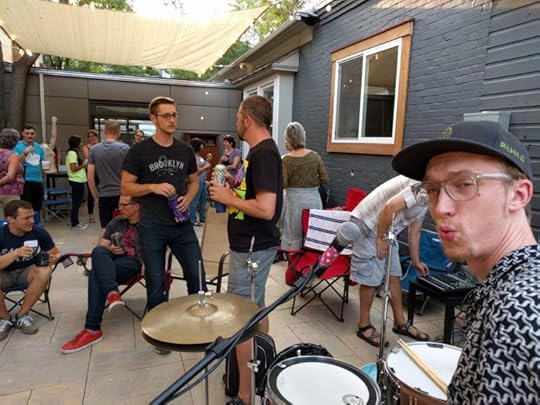
First an announcement: The Pop-up Business school is returning to Longmont this year for two golden weeks in September. Although the free in-person tickets are sold out, we are running a free daily live stream of the highlights, and you should definitely sign up here to join us.
…
I’d love to retire early, but then what?
…
Although I retired about thirteen years ago, and continue to be retired, about one year ago I opened up a little business on Main Street here in Longmont, Colorado. It is a multi-purpose gathering space, under the guise of a coworking space, with the typical-for-me grandiose name of “Mr. Money Mustache Headquarters”. Or, MMM-HQ for short.
At the time, I wrote a blog post about it, and promised to keep you updated on how it was going. Since then, many people have been asking for updates. Approximately one group of random roadtripping Mustachian tourists has stopped by each day to peer in the windows*. And several people are considering opening their own coworking spaces in other cities, if the case for it looks good.
Although this HQ is a small scale thing (we are hovering at about 50 members and I’d love to get to 80), it has provided me with some great lessons in both life and business, which are long overdue for sharing.
Plus, I can now fully vouch for the idea as a good one for other people to pursue, given the right situation. Owning a coworking or other community-oriented space can be both a good business and a great life choice, for people before or after the early retirement stage.
So, here’s what I’ve learned after launching into the most unexpected business of my life so far:
1: Owning a business can be like a having mental health therapist that pays YOU:
As I always say, early retirement is great, but it doesn’t mean you’re allowed to stop working. You need to accomplish something meaningful with almost every one of your days, whatever “accomplish” and “meaningful” mean to you. You also need to get out of your house, strain your muscles, have positive interactions with other humans, and experience at least a bit of hardship. These are simply parts of the recipe for Human happiness, like a series of buttons you can press to get more of it.

A therapeutic January morning in the Prisonyard Gym with special guest Jesse Mecham
So in my case, adding HQ to my life has been a very nice way to press more of those buttons. Almost every morning, I walk or bike or jog the 1.2 miles down to the building bright and early, open up all the doors for some fresh air, put on some music, and sweep the floors or make coffee or set things straight in preparation for the day. Then I head out to the patio and the “Prisonyard” outdoor gym beyond to do some basic weight training before I get sucked too deeply into computer work or any to-do lists.
As the day goes on, there will be a random stream of members and conversations and tasks and meetings and errands around town, which is just unpredictable enough to keep each day fun.
And the best part of it all is that it’s completely optional work. I can choose not to visit, and the members take up the slack and care for the place themselves. I can go on vacation and nothing blows up while I’m gone.
Owning a coworking space has all the benefits of having a really good office job where you like all of your coworkers, except without the accompanying obligations or politics. I refer to it as my therapist because a visit never fails to put me in a good mood, no matter how I felt before deciding to head down there. And a healthy and reliable way to make yourself feel great is an important part of any life.
2: It’s easy to arrange big events, but slower to create a consistently buzzing daily scene.
The year started big, with about 90 people crammed in for the first pop-up business school. Then, the vibe flipped around completely as we moved on to just a few people hanging around during normal days, working on laptops or perhaps the squat rack. But there have also been a pretty good series of after-hours events including barbecues, potlucks, regular meetups of the Northern Colorado Mustachians Group, a visit and Q/A session with YNAB founder Jesse Mecham, a Virtual Reality demo night, a music jam or two, and various charity and learning events and markets.
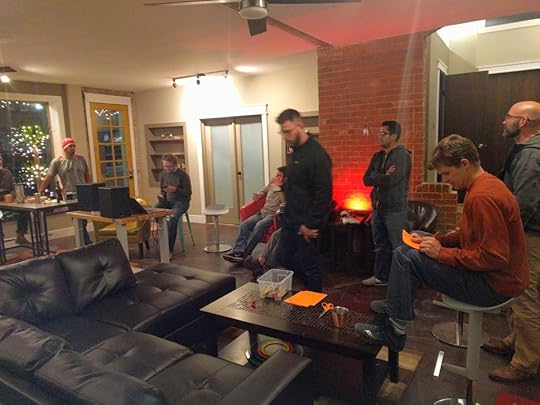
The annual Beer Club charitable meeting, comprised mostly of my neighborhood Dad friends.
On the down side, it takes more work to meet and sign up each new member than I expected, and we tend to lose more than expected, as people who signed up early but realized they don’t really need a coworking space have dropped out. And in the classic Blogger’s Dilemma where the demographic of the audience often reflects that of the writer, we end up with quite a high percentage of well-to-do white males in our 30s and 40s, which could lead to the term “Broworking Space”. But I’m trying to break this trend!
On the upside, the community side has been just as good as I had hoped. Thanks to the magic of our private Slack group, Members of HQ have been helping each other with both business and leisure pursuits on a daily basis and the connection has helped all of us including me. I often joke that my primary purpose for this coworking space is as a “Friend Harvesting Machine”, and it is living up to that promise.
3: The Money Side of Things
In principle, coworking is a good business model because it works a bit like a gym: you can have a large number of members sharing a common space because not everyone is there every day. This is why there are so many companies expanding into the business like WeWork, Regus, Proximity, Galvanize, and a zillion more.
But like any business, your income and spending need to be balanced. I’ve deliberately gone low on both sides, by starting with an affordable building and subsidizing it with my own mostly-unpaid labor. Because of this, the $2500 per month income (50 members at $50 each) is enough to sustain the place including property taxes, utilities, maintenance, beer (and artisinal coffee from one of our own members!) The downside of this approach is that our space is smaller and less fancy than other coworking spots. It was really just one big room until I opened the Tinyhouse conference room in June. Since the space is still way underused on any given workday, we could easily double this to 100 members, which would bring the business up to $60,000 of gross annual income – more than enough to sustain any reasonable lifestyle with very part-time hours.
Normal coworking spaces will tend to have a much larger building, with hundreds of members paying between $150 and $300+ per month for semi-private working spaces, or more for fully dedicated offices. This leads to higher rent and utility costs, plus the need for at least one full-time administrator and even a receptionist (although both can be the same person, which could be you if you are motivated.) The end result is a good income stream, at the expense of a business that requires real work on a fixed schedule.
So you can see why MMM-HQ is taking the slower paced road, for now.
4: So, should I start my own? (or join one?)
If you’ve got the time and energy, hell yes!
If you are thinking of opening a space in roughly the MMM-HQ model (or already have one), feel free to give me the details by dropping me an email via my about->contact form. If you start by putting up a good website with your proposed building/location, amenities, monthly cost and your contact info, I will link to it from my own HQ page, which will then become a directory for a network of community-oriented Mustachian coworking spaces. You can gather interested parties first before taking the plunge, although I would suggest that you only do this if you are financially well established and not overly dependent on the whims of bank financing.
Although I would (of course) charge no franchise fees, we could still set up an informal sharing arrangement where members of any Mustachian Headquarters affiliate location would be free to visit any other one.
And if you are wondering if joining a club like this is a worthwhile use of your own fifty bucks a month, I have to say it’s hard to see the downside as long as you use the amenities and like socializing with other people. If free coffee, beer, work space, an outdoor gym, tool library/workshop and access to fifty local entrepreneurs is not worth it to you, then I’m not sure what is!
—
In The Comments: Do you have any questions or comments about this or any other lifestyle or post-retirement business ideas? I’d be happy to answer them, and hopefully many other entrepreneur-readers will be willing to share their own knowledge and experience as well.
And Once Again: sign up for next week’s live stream series on how to open a Mustachian business, here!
—
*Out of respect to the members who are in there trying to get real work done, please don’t show up unannounced – instead, join one of our public meetups if you happen to be in the area, which I always announce on Twitter and usually Facebook too.





July 25, 2018
The Twenty Dollar Swim
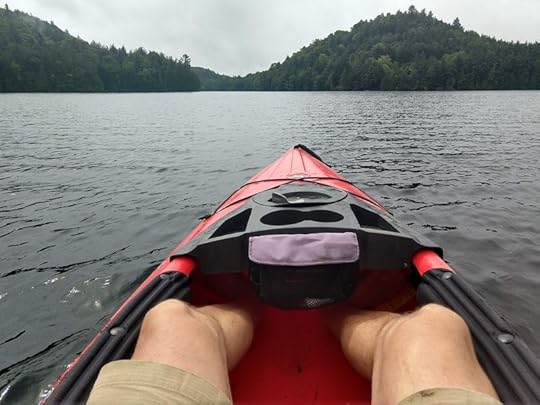

Gratuitous mid-lake selfie from yet another day of nearly-zero-dollar “motor”boating, earlier this week.
It was mid July, and I had just finished a sweaty run on the trails which criscross my older sister’s farm in Canada. I was overheated and heading straight for their swimming pool when she saw me walking across the lawn.
“Oh yeah, please do use the pool! You’ll help get my cost per use down because it’s still way up there in crazy territory”, she joked.
Moments like these are why I love being part of this family. The self-deprecating Spock-like humour where we can make fun of our own flaws and indulgences, while simultaneously enjoying them just as much.
But it also sparked an interesting conversation, because I knew they had been running this pool since the early 2000s, raised their two now-adult water loving boys in the house, and hosted gatherings for family and friends throughout every summer. And it wasn’t an exorbitant pool. Surely this was one of the more affordable indulgences, right?
“Has the cost per swim really been that high?”, I asked.
“Every jump into that pool has cost almost twenty bucks, if you average it out.” she replied.
“Wow, how could that be true?!” I mused.
So I did some rough calculations like those you see in the box below, which you can totally skip right over* if you just want the final answer.
The pool originally cost $30,000
But that money could have been invested instead, which would have compounded at 7% for these 18 years.
$30k compounded at 7% (30×1.07^18) is an amazing $101,300!
Electricity at 10 kwh/day x $0.20 at for 100 days per season is $200 per season or $3600 total
Chlorine and other chemicals: $600 per season add to $10,800
Maintenance like vacuums, nets, a new liner: $800 per season $14,400
We’re already at $130,000
Not even counting the hundreds of hours that went into scooping out bugs, spiders, mice, and even raccoons, and potentially higher home insurance premiums and water bills (in my region a 25,000 gallon pool costs $125 in water to fill – once!)
And how many swims were enjoyed in the pool? If every family member swam every day for every season, you’d still only end up at 18 years x 100 days x 4 people = 7200 swims.
$130 grand divided by 7200 is $18.oo
.
So the final number is about 18 bucks per person per swim, just as my sister claimed.
Looking forward to a refreshing dip with Mom and Dad and the kids? That’s $72 bucks that you ended up burning, by the time all the chips fell.
I know this is a strange way to think about a swimming pool. But this is a Mr. Money Mustache article, and this site is all about different ways to think about your life decisions.
Most people just say something like, “Well, we’ve already got it so we might as well enjoy it, right?”
The problem is that they also apply this to other purchases, even those they haven’t made yet. The richer our tastes become, the more likely we are to buy ourselves little upgrades “just because it would be nice”, or “just in case”, or because Joe Jones next door or a magazine article mentioned the idea.
“Okay Mr. Money Mustache, What Are You Taking Away From Me This Time?”
Don’t worry, I’m not necessarily going to strip you of your dreams of that swimming pool, or anything else. But I do want you to start thinking about these costs in a much more visceral and explicit way, so you can really make sure you are not fooling yourself. For example, let’s step through a few more common blunders:
“We had a great time visiting the Smiths in their ski house last weekend – LET’S GET ONE OURSELVES!” – sure, as long as you are ready to devote your financial life to the activity and the activity is worth $890.00 per night you actually spend there. But if this number sounds like anything other than chump change, you and your friends might want to just share an Airbnb for your ski weekends, or even better, take up local mountain biking instead of far-away skiing.
“I like these two houses equally, but one of them has a much bigger yard which is better for Junior to play in. They’re the same price and the bigger yard is just ten miles down the road!” – okay, but make sure that Junior’s time in the extra yard space is worth $150 per hour.
“I’m thinking of springing for the $9000 long-range battery in my upcoming Tesla Model 3 order” – this one strikes straight at my own heart, because I crave a long range Model 3 myself. But even for a serious roadtripper, this works out to $125 per hour of charging time that you manage to avoid. Aren’t you willing to take a few minutes occasionally to walk around and admire your beautiful car if you get paid $125 per hour after tax for it? If you are, standard range will do.
“I live in an area with snowy winters, so I need all-wheel-drive” since we already learned that all-wheel-drive does not make you safer, the only time it actually helps you is when it prevents you from being stuck. But this could work out to between $50 and $500 per time the AWD actually gets you out of a bind. Aren’t you willing to shovel your driveway a bit more thoroughly (or work from home on the worst days) for $500 a pop?
“We’d love to have an extra bedroom as a way of accommodating Grandma’s Annual Visit” Sure, but if you spend $30,000 extra on a slightly larger house and use that guest room 20 nights per year, it’s about $70 per night that you use it.
“I live in Chicago and we just love to spend weekends on the Boat.” Even if you go all-in and give up all your weekend activities on the land to maximize your time down at the marina, those nights in that little wedge-shaped cabin bed will average out to about $500 per night. Or more if you opt for a bigger boat or more time with the motor on.
“We love to explore and be free for a few months each year, so we’re getting an RV and towing the car…” But a three month, 15,000 mile RV trip works out to about $200 per night that you sleep in that vehicle – why not pick up a fairly new Prius and a good tent and hit the road, and treat yourself to beautiful rental accommodation whenever you want it along the way?
We could go on and on with these examples, but the real thing to understand is that making commitments usually comes with a bigger cost than you expect. There are a shitload of dollars at stake, but also a substantial portion of your focus and mental energy which will go into furnishing, maintaining, insuring, and cleaning these pleasant weekend distractions.
“But How Can I do It Better While Keeping My Life Fun?”
As a Mustachian, you have way more options open to you than you realize. But to take advantage of them, you need to stop doing what other people are doing, and live differently.
At the most frugal level, you can just cut yourself off cold turkey. From now on, just start doing all leisure within biking distance of home, and preparing all of your own food – no exceptions. You can still organize and host parties, however.
If you’re in a stressful debt situation right now and want to be out of it, you should just do this right now as a mental reset and watch the incredible results on your wealth. Most people who hit this reset button end up between $20,000 and $100,000 further ahead within just the first year, with many happy stories to share about it, so if you’re in need of a quick life boost, do this instead of dilly-dallying around with my rich person suggestions below.
But if you’re a debt free person with higher income and just want to accelerate your path to financial freedom, you can still dabble in the spendier life and keep up with your peers, by simply shuffling the luxury deck a little bit differently. A few principles that can still cut your budget by 75%:
Prioritize the healthy stuff first: It’s the weekend and you are ready to celebrate. But first, what’s on your to-do list? Are you fully caught up on your workouts, grocery shopping, and various nonsense with the incoming mail? If not, budget a full day for that rather than packing up the car for a road trip. How’s your yard looking? Have you fixed that door that doesn’t latch correctly? Well, look at that, your whole weekend is booked after all and you’ll feel better for it.
Muscle over Motor: If you like being on the slopes, learn to mountain bike. If you like being on the water, try a big, cushy sea kayak complete with cupholders for your sunrise coffee or sunset beer. Invite your fit and funloving friends and start exploring waterways everywhere. Or if you want a night out on the town, choose somewhere close and grab your bike rather than somewhere far and looking for your car keys or your Uber app.
Rent Instead of Buying: With Airbnb or even plain old hotels, you can still have weekend getaways when you truly deserve and can afford them, and yet the cost per use is much lower. The numbers will still look big, and that’s a good thing because you will be reminded that it is always expensive to leave your already-perfectly-good-home and go out to do even fancier things. When you’re living large, it’s best to joyfully acknowledge it rather than pretending it’s normal.
Make Special Arrangements: If you like cottages, make yourself useful to a friend who owns a cottage, by always being the one to bring the food or the wine, or donating your time to help with the maintenance or renovations. I helped build a cottage for my inlaws in Canada a few years back, and have enjoyed the fruits of our combined labor ever since – at no cost to the MMM family. Similarly, if you like boats, volunteer as part of the crew on a real yacht. If you like houses, specialize in building or renovating them, or hosting paying guests in the unused portions. If you like cars, become a car expert rather than just a car consumer.
The Final Word:
If you’re already eating and sleeping well, chances are that you already have all the basic ingredients for a happy life. So as you go on to start adding some spices to the dish as all of us do, just be sure you look at the price tag. The advantage you’ll gain will last a lifetime.
Epilogue: Just this year, after her boys had grown up and flown from the nest and all the fun had been had, they filled in the pool and are in the process of replacing it with trees and other natural landscaping instead. A bold move that few people would be rational enough to take – live long and prosper, Sister.
Extra Credit: Here are a few of the cost-per-use calculations I made for this article. Share some of your own in the comments!
Mountain house: $24,000 per year mortgage and/or capital cost, furnishings, utilities and maintenance divided by 30 nights per year. Plus $90 in car costs per roundtrip drive for a weekend.
Bigger yard: 1 hour per week of activities that really could not have been done in a smaller yard or an outdoor park, compared to 100 miles of extra driving ($50) and 3.5 hours of your time ($100) spent doing that driving.
Tesla Battery Upgrade: The only time you use the longer range is on roadtrips over 230 miles. If you do a 600-mile trip once every month, you have to make two extra 30-minute charging stops per month. Figure the $9000 battery costs you about $1500 in extra capital cost and depreciation per year, or $125 per month. However, if you are a Tesla fan like me and you want the company to make more profit to continue their mission, you may still opt for the extra options since you have nothing better to do with that money anyway.
All wheel drive car: if the car costs $5000 more up-front plus an extra $200 per year in fuel and maintenance, you could estimate it as about $500 per year more expensive to own. Then, how many times do you truly get stuck in a front-wheel drive car with really good dedicated snow tires on winter rims? (because snow tires always come before buying AWD!)
Grandma’s bedroom: a $30k more expensive house might consume about 2% of that extra cost in maintenance and taxes annually ($300), plus $5% annually in financing/capital costs ($1800), for a total of $2100 per year. Strangely enough, this extra bedroom works out to be one of the cheaper indulgences in this list, especially if you can use that room as an office too, or rent it out occasionally.
Boat: It costs about $15,000 per year to own, dock, store, transport, maintain, depreciate, and fuel a 26-foot motorboat with a little sleeper cabin in the front. If you spend each of the sixteen weekends of Chicago’s warm seasons exclusively in the boat, you’ve still done only about 32 days there, which yields the surprisingly high cost of almost $500 per night.
RV: Even a relatively small $50,000 RV depreciates about $0.50 per mile and burns fuel and oil and tires at another fifty cents. And that’s before you even pay for supplies, maintenance and nightly parking fees! Large RV travel is even dumber, financially speaking – note that the fanciest tour-bus-sized RVs you see cost about $500,000! The physics are simply against you if you are trying to travel in your own personal rolling building. Although stationary living in a not-too-expensive RV or trailer can be a highly Mustachian choice.
* I let you skip that one just so you would keep reading and see my point. But now that you see it, hopefully you also see that you do need to look at the numbers in life and figure this stuff for yourself, because it’s a way bigger deal than you might think!





June 30, 2018
My $3500 Tiny House, Explained

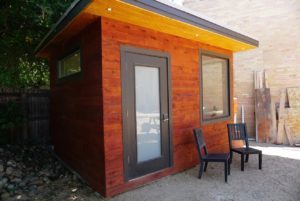
Meet “Timothy”, the new tinyhouse-style conference room at MMM HQ.
One of the nicest new trends of recent years is really the revival and rebranding of something very old: the smaller dwelling.
Over the last few months, I have built just such a structure, and it has turned out to be a rather cool experience. In fact, I’m typing this article for you from within its productive new confines.
Technically, it’s just a fancy shed. But it is functioning as a freestanding office building, a sanctuary, and would even make a pretty fine little dwelling for one person, if you were to squeeze in the necessary plumbing. It’s a joyful place to spend time, and yet it only took a moderate amount of work and less than $3500 of cash to create it.
The experience has been so satisfying and empowering, that it has reminded me how much we rich folk are overdoing the whole housing thing.

The latest and most distant Las Vegas Suburbs – still expanding (actual screenshot from Google Maps)
For decades, we have been cranking up household size and amenities in response to increasing productivity and wealth. In the 1940s, the typical US household had four people sharing 1000 square feet, or the equivalent of one large garage bay of space per person. Nowadays, new homes average around 2600 square feet and house only three people, which means each person floats around in almost triple the space. We have also started placing these dwellings in bigger expanses of blank grass and/or asphalt, which separate us further from the people and places we like to visit.
The funny part of all this is that we prioritize size over quality. Houses are sold by the square foot and the bedroom and the bathroom, rather than the more important things like how much daylight the windows let in or how well the spaces all fit together. And we settle for the shittiest of locations, buying houses so far from amenities that we depend on a 4000 pound motorized wheelchair just to go pick up a few salad ingredients.
Meanwhile, smaller houses and mobile and manufactured homes have continued to exist, but they have sprouted an undesireable stigma: those things are only for poor people, so if you can afford it you should get yourself a large, detached house.
My Tinyhouse Dreaming
Ever since my teenage years, I have dreamed of casual, communal living. 1992 still ranks as possibly the Best Summer Of My Life, because my brother and I lived a leisurely existence in the utopian garden-and-forest expanse of our Mom’s half acre backyard complete with swimming pool, fire pit, and pop-up tent trailer.
We lived at the center of small, historic town, with very little for teenagers to do in the summer besides find a way to get beer, and find somewhere to drink it so we could play cards and make jokes and if we were really lucky, find romance. And in these conditions, Mum’s backyard came to the rescue of our whole social group.
People would show up in the morning and just linger and come and go all day, swimming in the pool, grilling up lunches and dinners, playing cards at night or watching movies in the impromptu movie theater I had set up in the old detached garage. There were last-minute multi-person sleepovers every weekend. Leftover spicy bratwurst for breakfast cooked over an open fire in the morning. The fond memories from this early-nineties teen utopia live on in all of us*. So naturally, I have wanted to find ways to recreate that carefree feeling ever since.
According to people who actually study this stuff, the key to a really happy community and warmer friendships seems to be unplanned social interactions: you need to run into people unexpectedly every day, and then do fun stuff with them. To facilitate this, you need to live close enough together that you encounter one another when out for your morning stroll. Smaller, cheaper housing is the key to this, as well as a key to spending a lot less money on isolating yourself from potential new friends.

Weecasa resort (image credit Weecasa)
Need a few real-life examples? Right next to me in Lyons, Colorado, someone (I wish it were me!) thought up the idea of creating a resort out of tinyhouses called WeeCasa. Consuming less space than just the parking lot of a normal hotel, they have a beautiful and now highly popular enclave where the srooms rent for $150-$200+ per night.
Two friends of mine just bought a pair of adjoining renovated cabooses (cabeese?) in a Wisconsin beach town, with plans to create the same thing: a combination of a pleasant and walkable lifestyle with fewer material strings attached, and a stream of rental income when they’re not there.
Another friend built her own tiny house on a flat trailer platform, and has since gone on to live in a beautiful downtown neighborhood, both car-free and mortgage-free except for a small parking fee paid for stationing it in her friend’s back driveway. The monetary impact of making such a bold housing move for even a few years of your youth, is big enough to put you ahead for a lifetime.
Even my neighbourhood of “old-town Longmont” has recently inflated to the point of tiny starter home selling for $500k, for the same reason: people really want walkable, sociable places to live and house size is less important than location. While I’m in favor of this philosophy, I’m not in favor of anyone having to spend $500,000 for a shitty, uninsulated, unrenovated house. So we need a greater supply of smaller, closer dwellings to meet this higher demand.
But that’s all big picture stuff. The real story of this article is a small one – a single 120 square foot structure in the back of one of my own properties right here in downtown Longmont, CO. So let’s get down to it.
The Tinyhouse Conference Room

An interior view of our new workspace.
Nearing its one year anniversary, the “MMM-HQ” coworking space has been a lot of fun to run so far. It has been a mixture of quiet workdays, heavy workouts, evening events, and occasional classes and markets. (We have about 55 members and are looking for a few more, so if you happen to live in Longmont click the link above.)
But with only one big room as our indoor space, some members have felt the pinch of needing a quiet place to do longer conference calls or client meetings. So the plan has always been to build a couple of new spaces, and at last I have one of them mostly finished. And I made a point of documenting the whole process so I could share any ideas and lessons learned with you.
What goes into a Tinyhouse?
As with any big construction project, I started with a spreadsheet of steps and materials.

Here’s the complete list of steps and materials. You can click for viewing or download an .ods version for tweaking.
To save time, I tried to think ahead and get everything in one order **- most lumber shops will do free or cheap delivery on large orders like this. Of course, I ended up only partially successful and had to go back for missed objects, but I added those to my spreadsheet so your order can be more complete than mine.
At this point, it was just a matter of putting it all together, an effort which took me about 120 hours (three standard weeks) of work, spread out very casually over the past three months. Most of the work is standard house framing stuff, but just for fun we can step through it in rapidfire style right here.
The Super Simple Insulated Floor
Normally when building a small house, you’d dig a hole and pour a reinforced slab of concrete, as I did for the larger and fancier studio building at my main house. But in this case, the goal was fast, cheap and simple. So I just raked out a level patch of crushed gravel, compacted it with my rusty homemade welded compactor tool (“La Cruz”), and then started laying out pressure treated 2×6 lumber.

Here’s the 12×10 floor platform. Note the little support rails which allowed me to tightly fit in the foil-coated foam insulation between the joists. Most joints are done with simple 3.25″ galvanized framing nails, but I added Simpson corner brackets on the insides of the outermost joists for more strength.
Framing
Once I had those floor joists super square and level (hammering in stone shims under corners and joists as needed), I added a layer of standard 3/4″ OSB subfloor and nailed it down judiciously with the framing nailer to ensure a very rigid base. Then started to make the walls.
I used the floor as a convenient work platform for building the four walls. I built them flat and even added the 1/2″ exterior sheathing in advance, then tilted them up with the help of a friend or two. This method makes for heavier lifting but higher quality, because you get a perfectly straight and square wall almost guaranteed. Plus, it saves time because sheathing is a fussier job to do on an already-installed wall.
Once all four walls were set up and locked in place, I created the roof frame, which is really just a rather large wall. I did this on the ground, but had to compromise and skip the pre-sheathing step even though it would yield better quality, because we needed to keep it light enough to lift. If I had really strong friends or a telescoping forklift like real framing companies have, doing it all on the ground would have been a big win.

Framing and roofing.
A Metal Roof (of course)
I wanted a relatively flat-looking roof, so I cut wedge-shaped 2x4s and nailed them to the tops of the roof rafters before adding sheathing. This results in a slope of only 2%, but with a careful underlayment job and the seamless nature of metal roof sheets when compared to shingles, I have found it is nicely watertight. If in doubt, you can add more slope or use a rubber EPDM roof. The other advantages of metal: longer lifespan, lighter weight, and better protection from summer heat.
Insulation and Siding

Various wall layers revealed, insulation, lights, super frugal wood floor!
On top of those handy pre-sheathed walls, I added 1″ foil-covered foamboard, then some stained cedar fenceboards to create the reddish exterior you see in these pictures. Although the cedar gets quite a few compliments, it was an experiment I wouldn’t repeat: the boards expand and contract in changing weather and leave visible gaps at times. Next time, I’ll use more wavy metal siding, or something prefinished with an interlocking tongue and groove profile.
Electrical was done exactly the same way you’d wire up a normal house, with outlets and switches in AC Romex-style wiring. But on a tinyhouse like this, you might choose to have it all terminate at a male outdoor receptacle on an exterior wall like an RV or camp trailer, so you can run the whole thing from a good extension cord.
Insulation was just basic batts in this case, but you can use spray foam for even better performance. I drywalled everything using standard 1/2″ “lightrock” wallboard, hoping to keep the structure weight down in general, in case this thing ever needs to be moved with a forklift.
For lighting, I used these LED lights I found at Amazon at $4.20 per fixture.
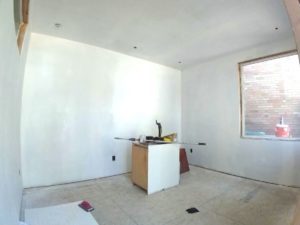
The bare drywall stage – one of so much promise.
The Final Touches – Interior Trim, Furniture and Climate Control
At this stage in the construction story, I had something that looked like any other ready-to-finish example of modern house construction, and it was such a happy and familiar feeling. It’s a blank canvas but also a very solid one upon which you can create anything – an office, a bedroom, music studio, living room. Or if you’ve got the pipes for it, a kitchen or even a bathroom with a fancy shower.
Normally by this stage in building a house, you’ve spent at least $100 per square foot, so you can imagine the pleasantly Mustachian feeling I got when I arrived here at about $22.
So to keep the frugal trend going with the floor, I decided to try just smooth sanding the raw OSB with a good belt sander and clearcoating it with this really tough floor urethane. It came out looking pleasant, and is very durable and mud/gravel resistant. But I found the sanding was a slow process – throwing in a basic but attractive engineered wood floor at under $2 per square foot is probably a better idea next time at only slightly higher cost, unless you are building a big enough space to justify renting a real floor sander.
I made my own trim and window jambs by buying three 4×8 sheets of 3/4″ MDF and slicing them up on the table saw. Like the floor, this adds a bit of labor, but the benefit is you can get nice beefy trim in whatever dimensions you like (and even throw in some matching custom shelving and built-in cabinetry!) and save a couple hundred dollars per room.
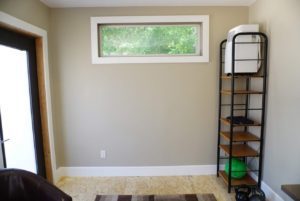
The portable air conditioner occupies only one shelf.
For furniture, I picked out a mixture of stuff I already had, an Ikea desk frame from Craigslist, and a nifty chairside table from a local big box store.
Finally, I added some simple but effective climate control by just throwing a low cost portable AC from amazon up on the shelf (it vents through a 6″ hole I cut to the exterior). In the winter, I’ll just stash that little air conditioner somewhere and replace it with a silent oil-filled electric radiator for heat.
By plugging either of these machines into a wifi-controlled electrical outlet, I can even control the heating and cooling from anywhere using an app on my phone, as I already do for the various patio lights and ventilation fans I have in my life.
So do YOU want a Tiny House?
The real point of this article is just to share the idea that small structures can be very useful for many things. They are quicker and cheaper than creating a traditional house or building an addition onto one. They may allow you to have a guest house or home office or even an AirBnb rental in space that was formerly just a water-sucking part of your back lawn. Many cities allow you to place small things like this in your yard without requiring a building permit. And if you have the skills to build these things, you can even create an instantly profitable business cranking them out to satisfy the strong demand.
As for me, I’m hooked – later this year I’ll build a second one of these things here at MMM-HQ. And perhaps I’ll even get a chance to help someone build yet another in a tropical seaside location this winter, as part of my ongoing “Carpentourism” habit.
Happy downsizing!
—
*except my Mum, who still regrets letting so many teenagers run free and attract the ire of the older neighbors and occasionally the police department. Sorry Mom.. but also, thank you so much!
** I also took advantage of the large chunk of spending for a tiny bit of “travel hacking“, picking up an Amex Platinum card that gives me about $1000 of cash/travel credits only if I can spend $5000 within the first three months. For travel hackers, timing the acquisition of a new rewards card to coincide with a chunk of planned spending can be a useful way to squeeze the travel budget into an existing renovation budget.





May 15, 2018
A Day In The Life of my Supposedly Frugal Stomach

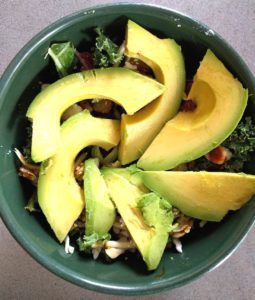 Kicking Ass with Money is much like healthy eating and joyful living. It’s a series of daily habits that get you ahead, rather than a one-time heroic effort that fixes all your problems so you can go back to whatever you were doing before.
Kicking Ass with Money is much like healthy eating and joyful living. It’s a series of daily habits that get you ahead, rather than a one-time heroic effort that fixes all your problems so you can go back to whatever you were doing before.
Because of this parallel, the subject of food is one of the nicest examples of Mustachian living, and one of the most powerful and efficient things to master.
Your eating choices will drastically affect your budget (especially if you are raising a family), but they also affect your health, energy levels, productivity, and happiness. The path to a great life goes directly across your dinner plate, so it is important to take this shit seriously and not mess around with your nutrition.
I’ve written about food several times before, sometimes with a focus on recipes or costs or general principles. But people often don’t believe me – they think I am either lying about my family’s grocery spending, eating a diet that is poor in nutritional value, or at least spending an inordinate amount of time on meal planning and preparation.
The truth is none of these things, although the actual story may still surprise you. So I thought that instead of issuing vague commandments like the preacher I am, I could share my functional and (somewhat) affordable eating style, even though it’s unusual and surely not for everyone.
So I’ll lay out a single day’s nutrition strategy, and why I think it is a good one. And then you can choose whether to ridicule it on Reddit, or adopt any tricks from it that you like for your own family. Are you ready? Then let’s take a trip into the MMM kitchen!

Alongside the Table Saw, the Cutting Board is also a favorite tool.
The first bit of crazy is that when I’m home, I eat almost the same thing every day. My son eats exactly the same thing every day* for now, and Mrs. MM runs her own show, perhaps with a bit more variety than either of us. This is a unique situation in our family that is different from most, and it adds extra complexity but fortunately not extra cost. You play with the cards you are dealt.
Most Important is your Eating Philosophy
For most people, food is just an automatic routine. They eat whatever seems tasty whenever they are hungry. People with stronger passions (sometimes known as Foodies), spend a large part of their day and mental energy seeking out perfect ingredients and flavors and meals. And for many, eating is an addiction – food calls to them (especially desserts and snacks), and they fight this addiction with varying degrees of success. People with a busy urban social life like New Yorkers get most of their food from restaurants, which throws both the nutrition content and the monthly cost into a randomizing hat.
The problem with all of these philosophies is that each is a huge gamble, with your life as the stakes. Because depending on your body chemistry and the foods you choose, you can end up anywhere on the health scale – I have met sweating car bound 25 year-old office workers who could barely stroll from the parking lot to the building, and also know a ripped 65 year-old carpenter who can still frame a three-story house by himself. The difference in the diets of these two men is as stark as the contrast in their physiques.
So my eating philosophy has always been that of the Engineer/Robot. Design each meal and each day’s food intake, according to my body’s current needs. Since my activity level changes drastically (yesterday’s mountain hike requires several times more calories than today’s work on this blog article), the food intake has to change accordingly. And since I don’t always get things exactly right, the mirror tells me when it’s time to make adjustments.
And finally, I’m a big fan of high standards and not fooling yourself. Stay lean and keep your body in condition to work hard. Learn to use the mirror, the measuring tape, and the scale as allies rather than generators of guilt and fear. If you’re not there yet, keep yourself moving in the right direction rather than being complacent. For example, if my abs get paved over with fat, I’ll adjust the variables below to go into fat loss mode until the problem is corrected. On the other hand, if I’m getting too skinny and trying to put on strength and weight, I’ll add the extra meals back in.
The Weird MMM Meal Plan
Breakfast
I have come to think of Breakfast as the time of Breaking the Fast.. but by now we all know that fasting is good for you, right? So the design of your breakfast presents an interesting life-boosting opportunity: When you wake up, you’re already in a nice low-blood-sugar state, which means your body is beginning to think about burning fats as a source of energy (ketosis). This means that you can just prolong the fast by skipping breakfast and just enjoying some coffee or water, or take a softer approach and at least have a breakfast that is very low in sugar. So I do this:
Coffee with Whole milk and Coconut oil
A handful of mixed nuts
A few squares of dark chocolate (85%)
Subjectively, I find this breakfast is satisfying and delicious, but also keeps my body in low-sugar mode so I can begin a day of physical labor without hunger – and potentially work as long as I want, even skipping lunch and running on stored bodyfat if desired.
The end result is this nutrition profile:
At this point, you may be asking, “Wait, does Mustache really weigh and analyze his food?” – and the answer is “sorta.” While I endeavor to lead a relaxed, hippy lifestyle, the Engineer/Robot side is always in the background running the numbers. If you have at least a rough idea of the nutrition content of what you are eating, you will have a far easier time getting the results you want.
Mid Morning Snack
After breakfast, I usually bike downtown to a mixture of construction and weight training in the back “prisonyard” of the MMM-HQ Coworking space. After a few hours of this, I am ready for a bit more nutrition:
A giant salad
Plenty of water, or even the indulgence of a second cup of coffee
These big salads are a big part of my daily food expenditure and effort, but probably an even bigger part of my health. So they are definitely worth it. I make it easier by making salad in bulk every few days, and starting with a base of a pre-made $2.28 Kale Salad Kit from Sam’s/Costco. This provides a bunch of greens and saves much chopping. But I discard the crappy sugary dressing that comes with the kit and use my own olive oil-based dressing, also made in bulk from high quality ingredients also bought in bulk, (like 3 Liter Jugs of olive oil!)
I may throw in a protein bar (30g protein, $1.00) to this snack, depending on the intensity of the work.
Lunch
After the midmorning snack, I am back out for quality time with the saws and ladders for a few more hours, which feels great on a relatively light load of food because the body is burning clean and lean. The low carbohydrate nature of everything I have eaten so far keeps the hunger level so low that I could even work right through and skip lunch if needed, or if I were trying to lose fat. But since I’m currently at roughly right fat level and not wanting to be any lighter than I am, I break at around 2PM for something like this:
I have been on a bit of a Tilapia binge in recent months, because they are almost too convenient and tasty and easy to prepare. So much so, that I jokingly refer to them as “marriage savers” – there is no need to fret over whose turn it is to prepare dinner, if something with such a good nutrition profile is always in the freezer and just 15 toaster oven minutes away from your tongue.
While the nutrition profile is good, they are still a bit of an expensive source of protein. $2.00 sounds like chump change, but the same protein can be had for under fifty cents from other sources like bean and rice combinations, eggs, or even whey protein supplements.
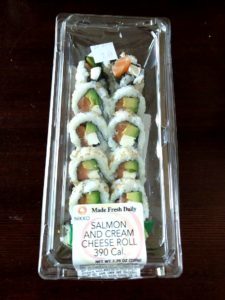 A cost difference of just $1.50 per person per meal, multiplied over a four-person family’s 372 meals per month makes a difference of $558 per month, or about $96,000 per decade after compounding.
A cost difference of just $1.50 per person per meal, multiplied over a four-person family’s 372 meals per month makes a difference of $558 per month, or about $96,000 per decade after compounding.
Yes, that is a hundred grand, and this is just the difference between a semi-frugal $2.00 meal component and a fifty cent equivalent from, say, your crock pot.
Imagine, then, the effect that impulse grocery purchases like those little $7.49 packs of sushi would make, if you casually toss them in the cart on a regular basis? A decade of a family’s innocent-seeming Whole Foods indulgence could pay for a house outright, while leaving them no better nourished than wiser meal planning with bulk ingredients.
Put a crock pot and a Costco membership to good use, and just watch what happens to your bank account.
Now, I took that sushi picture on my own kitchen table, so we too are guilty of this indulgence. But we are long past financial independence, and even then it is a rare purchase. The overall lesson is just, again, to take this shit seriously – make sure you appreciate every food purchase above beans-and-rice level as a conscious luxury rather than just a habit. And if you are in debt, no sushi for you!
Dinner

Another typical dinner – main dish is based on potatoes/veggies plus fancy sausages baked into a cheese-laden casserole.
Around 3:30pm in the afternoon, I’ll walk or bike home from “work”, so I can be there when my son returns home from school – one of the biggest rewards of early retirement. One of us parents will cook him a homemade pizza at this point (I pre-make the personal size shells and keep them in stacks in the freezer), so he can recharge with about 480 calories from a delicious meal that costs only about 50 cents to make.
Then us Adults will usually collaborate to make something like pulled-pork tacos:
On the side, we might add chopped fresh vegetables, more salad, or something more substantial as the appetites require. Like the filets, it’s not the cheapest possible way to get a meal, but at least it is reasonable. Also, we are omnivores, which is a more expensive and polluting way to get protein – but if you’re not badass enough to eat vegetarian you can at least make a substantial dent in your eco footprint by making beef your last choice of meats.
Adding it All Up
Although it took me quite a few hours to collect all this data on what I eat and add it up in a spreadsheet, the results have been quite interesting because I had never done it before. With just the stuff described above, I arrived at this point:
And the numbers were a bit surprising to me, in the following ways:
I am spending a lot more on food than I thought. If all three of us ate the way I do, our annual grocery bill would be $8600, not counting additional indulgences or food for parties. Since our real bill is closer to $6000, you can see that I am doing more than my share of the spending. Then again, I do weigh more than both Little MM and his mother combined , so perhaps this is fair.
My base calorie level is about right for my age and height for a moderately active person, but on active days I need closer to 4000 calories (if you look up a 185 pound male “athlete” for the baseline)
My base protein level is also about right for moderate activity, but on highly physical or weight training days I like to boost that to one gram per pound of bodyweight.
So while everything in this article is detailed and accurate so far, I tend to eat a variable amount of additional food to meet hunger needs, scaling it all up and down depending on what the mirror says. I use one or more of the following boosts.
Boosts
Handfuls of Nuts (1 ounce worth, 160 calories)
Protein Smoothie (banana, peanut butter, plain yogurt, tiny bit of milk, ice, water, and vanilla protein mix – about 1000 calories and 40 grams protein)
2-3 simple eggs cooked in olive oil with a bit of cheese: 500 calories, 20 grams of protein, 50 cents or so.
Avocado toast: 3 eggs, some shredded cheese, avocado, all on a piece of whole wheat toast with butter. A truly decadent weight gainer of a snack, although quite cheap. Leave out toast if you are not trying to maintain or gain weight. 1000 calories, plenty of nutrients about a buck.
*and while I won’t explain this in detail here, parents of children with his personality type will understand without question. It is something people do tend to grow out of as they get older and gain confidence with new experiences.





April 10, 2018
Hacking Hedonic Adaptation to Get Way More For Your Money


After three years, wall-mounted toilet paper has become the latest thrill.
When I built our current house, I decided to do as much of the work as practical myself, because I learned years ago that this is the most satisfying way I can possibly live.
I love sitting back late at night, especially during cold winter nights or intense summer rainstorms, and looking up at the high ceilings and the ornately framed windows and thinking about all that structure holding itself together and protecting us so nicely inside. Satisfaction.
Sure, practicality also required some compromises – I hired out the big, repetitive task of drywall, and hired friends to work with me on the heavy parts like framing the roof.
But as soon as the house was even remotely habitable, with plywood kitchen countertops and no bathroom sink, we moved in. This allowed me to keep working on the place without being away from the family, and also to move out and stage the previous house nicely so we could put it on the market.
That was in early 2014, and true to my nature I’ve never really stopped working on the house since then. The first things were urgent, like quality countertops and sinks and faucets, appliances and light fixtures and functioning closets, so I did these things quickly. Then I installed a really nice woodstove before that first winter came, then built the second bathroom, and moved on to renovate our son’s room in the old wing of the house that had not been part of the fully rebuilt section. Then more closets, trims, cabinetry, little features here and there as the need arose, and even the rather major feature of the detached Rock’n’roll Studio.
There have been a hundred little upgrades, always arriving with random timing, as time permitted. And the interesting thing about them has been this:
Each little upgrade – whether big or small – has brought a similar amount of short-lived but genuine happiness.
When I upgraded the countertops from plywood to stone, we were all thrilled at the new, smooth and easily cleanable nature of the kitchen. Then after a week or two, this thrill became the new normal, and it was gone.
But then, I added shelves to a closet, and fighting with piles of clothes in laundry baskets became a joyful flip through a row of hanging shirts and nicely folded pants on smooth wooden shelves. Another thrill! For another couple of weeks.
On and on these small upgrades went, each one accomplished by my own two hands, so that I got the satisfaction of a job well done, and also lived in a house that was constantly getting just a bit better every week.
Looking back, this has been so much better than just moving into a pre-made, perfect, fancy house that somebody else built for me, and doing it this way has also saved me hundreds of thousands of dollars at the same time. And even if you’re not a carpenter yourself, you can get the same benefits by understanding the human pychology at work here.
Hacking Hedonic Adaptation.
You may recall me cautioning you in this long-ago MMM Classic, to avoid buying yourself fancy shit, because the thrill of every new life upgrade – whether it is a nicer dishwasher or a faster Mercedes – always wears off, and your overall life happiness returns to exactly where it was. It’s quite an un-intuitive result, but if you watch yourself over time, you will notice it is uncannily accurate.
For example, I started this blog seven years ago in 2011, and distinctly remember being very happy with life, even way back then. Sure, I had problems just like everyone else, but on balance it was still a great life, because I was already pressing most or all of the actual buttons for human happiness
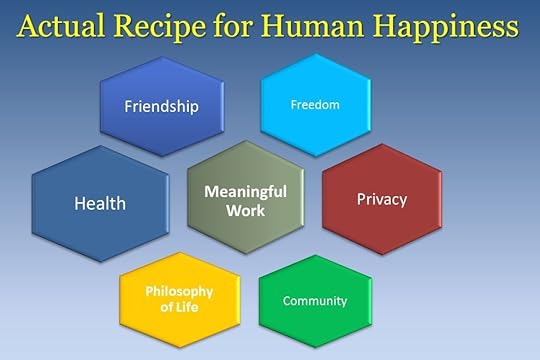
Some of the recipe for happiness (a slide from my WDS talk)
Since then, I have stumbled into a few upgrades:
A nicer house
A nicer bike (several, actually)
A nicer car
A nicer dishwasher
Internet fame
Several times more money than I had before
A really fun new business (the MMM-HQ coworking space)
And many, many other nicer things (clothes, electronic gadgets, interesting trips, and so on)
And yet, I’m still not really any happier than before, sitting here right at this moment. My life looks more prestigious and luxurious on paper, but since I was already extremely fucking happy with life before, there was not much to improve.
This brings up a strange paradox. Because I also remember feeling quite giddy and thrilled with each of these upgrades as I made them. Those happy feelings were genuine. What Gives?
The Happiness Bump
The phenomenon at work was the temporary thrill of a new life upgrade. If we were to sketch it out on paper, it would look like this:
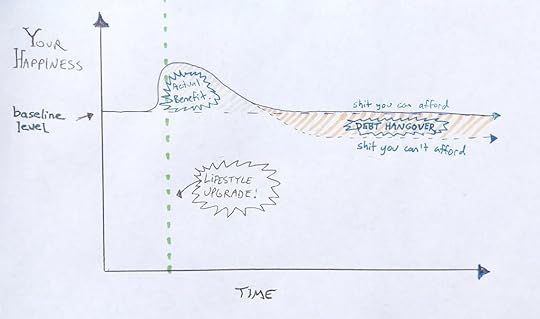
The Short-term Happiness Bump from lifestyle upgrades
As you can see, you make the upgrade, and you do get some genuine thrills for a short time.
The key thing to know about your happiness is that you have a ‘baseline’ level. Some of it is genetically inherited, but you can also have a strong affect on it yourself, by pressing the genuine happiness buttons in the diagram above.
Most lifestyle upgrades (cars, dishwashers, or even my new toilet paper holder) do not press these buttons, unless they truly address a shortfall in your previous life.
In the best possible outcome, you might make a life change that helps you gain new skills, increase your health, or improve your life’s core relationships. This could stretch out the shaded “Actual Benefit” part of the graph to be much longer, in the extreme cases for your whole life.
But in the typical outcome, most of us make changes that produce only a short bump, and then may even come back to haunt us with a payback time (which I labeled the “debt hangover” in the picture. Anything that puts you into debt, makes you less healthy or otherwise compromises your ability to live a happy life fits into this category.
Putting it into Practice
Your job as a wise, badass Human is to understand your strengths and weaknesses, and then arrange your life to make the best of things. The temptation to pursue shiny but useless upgrades is one of our biggest weaknesses. So try the following hacks:
Consider each potential change (whether it is a purchase, a trip, or a lunch out at a restaurant) from the perspective of one year in the future. How much better will your life be in one year, if you make this decision right now?
Delay everything and space it out as much as possible. The anticipation of a treat often provides at least as much joy as the consummation. Simply doubling your waiting period will cut your spending on this stuff in half.
By cutting your upgrades into smaller pieces (as I did with the piecemeal home construction), you get to experience the thrill more often.
Put your priority on upgrades that remove a strong daily negative or a barrier to happiness. For example, upgrading from a 2009 to a 2018 BMW will very likely not make you happier, but upgrading a barely-functional bike or shitty kitchen faucet to a to a good one you use daily can make a real difference.
Find ways to modify each potential upgrade so that it presses more of your happiness buttons. Make it more challenging, do things that require you to learn or accomplish something first, choose things that allow you to create or strengthen friendships, and choose the healthier options out of any alternatives you are given.
Use your temptation to buy or consume new things as a habit trigger : catch yourself in the moment of weakness (because this happens automatically and frequently), and use this to do something good for you instead. For example, every time I walk by my fridge and gaze longingly at the handle, thinking of pulling out a cold beer, I am reminded to go out to my back patio and do 100 pushups instead. In really disciplined times (like the last few months for me), I back this up by also not keeping any beer in the house. But even if the end result is a bubbly reward, I have improved the reward bump by packaging in a permanent benefit (fitness) with the otherwise very short term reward of a drink.
And finally, keep a list of your top life priorities on your fridge door, or your work computer monitor, or somewhere else that you see it many times per day. Stuff like better friendships, better parenting, health, financial independence, happiness, personal growth. Looking at this list before you decide to do anything – whether it’s planning a lunch or moving to a new house, can serve as a surprisingly powerful anchor to help you fine tune your happiness bumps – stretching out the good parts and eliminating the hangovers.
Happy Hacking!
In the comments: which life upgrades have you made that ended up producing neutral results or even regret, and which ones have provided more lasting happiness?





March 9, 2018
Money and Confidence are Interchangeable

 So, I’m assuming you are here reading this because you want to get yourself some more money.
So, I’m assuming you are here reading this because you want to get yourself some more money.
And since this is Mr. Money Mustache and not a standard financial publication, you’re willing to think about the bigger picture:
Not necessarily “Maxiumum money at all costs so I can have a nice, spendy retirement!”
More like “A good, fun amount of money so I can walk outa this cubicle with confidence and never look back.”
Making that mental leap is a huge one. It takes you from a life of permanent pursuit of the unattainable, to one where you get to the “Enough” stage pretty quickly. This alone will change the course of your life for the better.
But what if there were an even bigger mental leap that we were leaving out? One that starts with the hard-nosed math of living off of your investments, but then puts it on a more flexible scale that allows you take shortcuts and attain the freedom you want, much sooner?
Well, there is such a shortcut of course, and there is even a story right from my own life that illustrates it.
The Unnecessary Fears of Teenager MMM
Since I was a kid, I’ve always had confidence issues. I was afraid to attend the birthday parties of other kids, if there were too many strangers around. I was afraid to try new foods or join any teams. It took me a long time to become outgoing enough to start meeting girls in high school.
I compensated for these things by trying to be really good at everything, in an attempt to alleviate feelings of worry. Insisting on A+ grades even on the most pointless of assignments, just because I felt that “winning” was a safe defense against bullshit workloads.
I engaged in slightly compulsive weight training and with some of my fellow status-seeking schoolmates until we were all well-dressed two hundred pound muscleheads, safe from the risk of bullying and gleefully (but needily) soaking up the status rewards of having more prestigious outer appearances. We would have all claimed it was for fun reasons or health reasons, but there was plenty of teenage insecurity driving up those barbell plates at 5:30am as well.
Even as a young adult, my desire to build up a massive financial surplus was probably at least partly driven by a desire to protect myself from things that could go wrong – like unemployment or being stuck in a job that I no longer enjoyed.
I’m not ashamed to admit all of this, because you need to see your opponent clearly in order to beat it. I went through this journey of insecurity and came out on top – in the safety of a well-designed life with lots of advantages. But since then, as I have spent the subsequent thirteen years learning more about that life, and meeting new people with entirely different successful lives, I have come to realize something I wish I could have known earlier:
I had nothing to worry about in the first place.
It turns out I didn’t need all that money, because my needs and wants will never be more than I earn from my natural desire to do useful work. You don’t need to be a musclehead in order to have friends or meet attractive people or deter bullies – normal fitness is just fine and being friendly and open is much more attractive – whether your goal is finding love or running a powerful enterprise.
You don’t have to OVERACHIEVE at everything you do – you can be strategically great at things you truly enjoy, carve the rest of the unnecessary crap out of your life, and spend your days in a much healthier balance of work and play.
Many of us are focusing our energy on building up the wall of protective money and insurance policies around us to ever-greater heights, working one last year and funding one last insurance policy against an obscure risk, when really our deficit is not in money. It’s in confidence.
And thus, it turns out that Money and Confidence are Interchangeable.
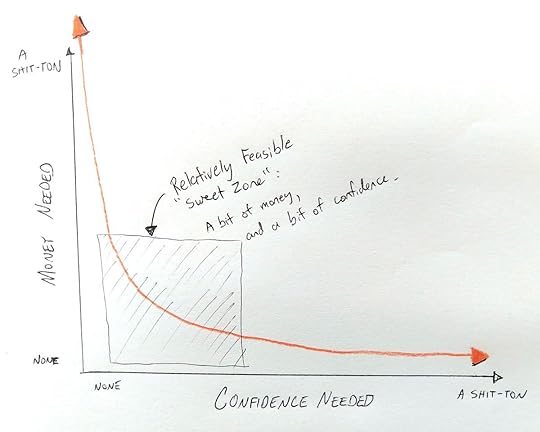
Figure 1: With no confidence, you need a shit-ton of money to feel comfortable. Find a smarter balance.
Think about it: It took me seventeen years of school and ten years of work to become an expert software engineer, making a growing six-figure salary and with a million dollars* of investments by about age thirty.
But then, years after retirement I started a carpentry business just for fun, and within just a few weeks of spreading the word, I had enough business to easily pay the bills with very part time work. It was a lot of fun. So, would a sufficiently confident carpenter really need to do the engineering career and save that million, in order to live a satisfying life?
In 2011, I started this website to write about money. Even without the lottery-like success it has lucked into, I would have still ended up with a writing career in a popular subject that was loads of fun and could again have easily paid the bills through things like consulting, advising, speaking, or connecting with new friends for business opportunities. And I’ve enjoyed writing since I was ten years old – with enough confidence, I could have started writing about money decades earlier.
In 2017, I bought a small commercial building alongside some friends and converted half of it into a coworking space, and it easily filled up with members. Despite charging only a third of standard rates, the income from this business would also be plenty to fund a happy family’s lifestyle. If I had the confidence earlier in life, I could have shortcut the intervening work and achieved almost exactly my current lifestyle decades ago: no war chest of investments required.
More important than these examples from my life, are examples from yours.
Every day, I get emails from people describing their plentiful savings and unpleasant jobs, and then a description of the golden handcuffs or fearful assumptions that keep them working in their jobs.
They wonder when, if ever, they’ll be able to quit. When really, the problem is not the money, it’s the confidence. With confidence, they could quit right now.
Confidence allows you to change your current life entirely and instantly, without the need to change anything – because you’re just rearranging the feelings in your mind.
Imagine for a moment that you’re Jill CTO or Joe Attorney, locked into a prestigious firm and a two point six million dollar Washington DC dream townhouse. You’ve got an entire department reporting to you, your ex-spouse to manage, two kids in private schools, a standardized and rigorous vacation plan to address both sets of inlaws, and a comfortable, safe 2016 Lexus Hybrid SUV that you use several times per day because although you agree with Mr. Money Mustache that more people should be riding bikes, it just doesn’t work with your lifestyle right now.
You’re a high achiever, no doubt about it. But what is all this achievement buying you in life happiness today? Are you selling off your current years of youth to The Firm, and putting off your happiness because in just another decade or so, once the kids are grown and things settle out, then you’ll give yourself permission to be happy?
If so, you may have confidence issues, just like the rest of us.
What if could take all that complexity and ass-covering and self-protection in your current life, set it aside, and consider the following ideas.
In fact, let’s repeat all of this together in the first person so it sinks in for real:
A Recipe For Badass Confidence
I will always be able to get a job if I need one.
Billions of people are living far less expensive lives than mine, and yet many millions of these people are surely happier than me. What is their secret?
While I don’t control the entire world, I am in control of my response to everything I experience. And my response is the part that determines my happiness.
I am in control of my cost of living. Everything I do is a decision, and it’s made by me, not the world around me.
I can always learn new things. With proper dedication, I can gain any skill that I want or need. This means when I depend on other people, it’s just a positive choice we are both making. When others depend on me, they are acknowledging my strength and I will choose to pass some of it on to them.
My kids will be just fine. Just by giving them my love and support and being honest with them. They don’t need prestige and they don’t need the support of multimillionaire parents to prosper in life. Nobody does.
Exotic Travel (just like any other luxury) is not a necessity for a happy life. At a moment’s notice, I could choose to spend the rest of my life within driving distance of this spot, and still lead a completely blissful existence forever.
But on the other side of that same coin, I can always move. My current location is a mixture of chance and choice, but people move all the time and their lives are usually better for it.
I can always make friends. No matter where you drop me in the world, I could build up a loving support network of warm and caring relationships. Because people are the same everywhere – we all just want to be valued and given some warm attention.
I know that my real goal in life is happiness, and I will always have the right tools available to me to maximize my happiness. They’re everywhere, and they are free.
Millions of others have achieved this before me, with fewer advantages and in harder times. I have more than enough personal power to get this shit done, in spades.
That collection of points above, is my personal version of what Confidence means. But you’re welcome to use it, adapt it, even turn it into a t-shirt or tattoo for yourself. Confidence is the opposite of fear, and fear is the enemy that has stands between most people and greater happiness.
And because it’s interchangeable with the need for money, that dozen or so bullet points can easily be worth millions of dollars.
The biggest bonus about this multimillion dollar recipe? If you haven’t followed it before, your initial results will come strikingly fast and fuel your desire to get yourself even more of it. Confidence is addictive, joyful, and self-reinforcing.
What To Do With This Amazing Power
You now have two complementary tools in your belt: Money, and Confidence. Both of them are useful. But it would be foolish to develop one exclusively, while completely ignoring the other.
Most people work too much on the money and use it to compensate for a lack of confidence. To get to the next stage in life, you will need to stop doing that.
The Freedom to live happily is your goal. Confidence is part of the price of admission.
*based on 2005 retirement date inflation adjusted to 2018 dollars





February 7, 2018
My DIY Solar Power Setup – Free Energy for Life
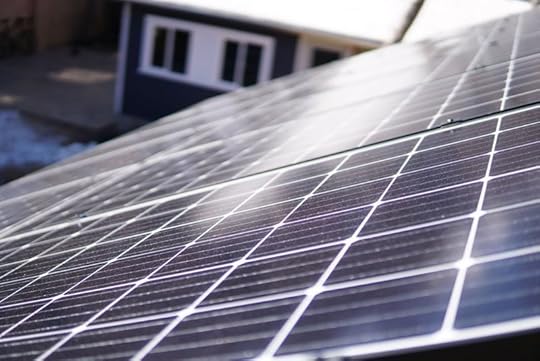
It is pretty well known at this point that Mr. Money Mustache is enamored with solar power. Besides the obvious Sci-Fi coolness of it (Electricity, Satellites, Futuristic Robots!) and the eco-friendliness of it (energy with zero noise or pollution), in the last five years the money side of things has finally matured, so that solar power is now the cheapest way to make electricity – even before you account for the added bonus of any available subsidies and the benefits of pollution-free living.
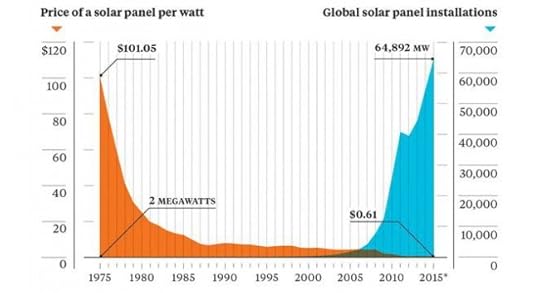
A Watt of Solar Panels: From $100+ to under fifty cents (2017) in less than my lifetime (image source cleantechnica). And the 2017 number for the blue side of the graph hit over 95,000 MW.
It works for individuals: In many cases, if you can get a good rack of solar panels on your roof, your monthly savings will be equivalent to making an investment that performs better than the stock market. But the numbers look even better as your solar setup becomes larger, like if you’re running a solar energy utility or a community solar farm.
Related: In recent Colorado Energy Bids, Solar energy is the cheapest option, even when backed by battery storage (Vox).
The fun part of this for me has always been the physics. Ever since I learned how much energy the Sun shines onto our planet’s surface (about 16,000 times more energy than all of humanity consumes, even with our current bloated habits), I have been certain that a mostly-solar-electric world was inevitable. The only obstructions were human inertia and politics, which are temporary. Physics is forever.
For example, consider the following map showing the tiny amount of our deserts we would need to cover with solar panels to replace all energy consumption (electricity, oil, gas, nuclear, hydro, wind, etc)

Fig. 1: Tiny land area required to power all of humanity. (image source)
And it’s actually even better than that: the image above assumes an old-school solar panel efficiency of 8%, whereas 18% is now a standard rate. So you can cut the black dots in half again, and then chop a few more times to account for the other existing clean energy sources.
And of course, you don’t have to concentrate the panels and run giant power lines everywhere as implied by the map. You can stick solar panels virtually anywhere and they will start working like little employees for you, tirelessly cranking out energy (which is equivalent to money) and automatically.
Which is of course the real subject of this article.
My DIY Solar Project

The new solar array at the MMM HQ workshop generates more than enough power to run the whole property year-round, plus charge the electric cars of the various members.
So naturally, I have always wanted to have my own solar power farm. Until now, various excuses kept me from getting it done: no great places to put panels on the roof of my main house, slightly unfavorable local regulations, but mainly a lack of knowledge of exactly what to buy and how to install it.
I vowed that whenever I finally got this project done, I’d write up a report to you, to spare you some of the research and time consumption that I had to go through.
So let’s get into it!
Part One: Show me the Money
As you can see from the picture above, I’ve started by building a relatively small solar array. There are twelve panels, each about 40 x 60 inches. Each one generates 300 watts of electricity when the sun shines, and when you run the numbers for my climate, the whole setup will crank out about 6100 kWh/year of electricity, a chunk which is worth about $732 per year at average US power prices.
Pretty amazing – enough energy to run my coworking space and Mrs. MM’s adjacent retail store… from a chunk of pretty black glass that is about the same size as a single car parking space!
Meanwhile, the wholesale cost of this equipment broke down roughly like this:
12 solar panels at $130 each: $1656 (a total of 3600 watts at 46 cents per watt)
12 Optimizer modules (which increase power output during partial shade): $650
One SolarEdge 6 kW Inverter (converts the DC current from the panels to AC for the grid): $1102
Various brackets, mounting racks, bolts, and wiring stuff: $460
So my total cost, due to the very good luck of having a friend who is both a dedicated Mustachian and the owner of a booming solar company, was $3900.
That’s the best case, but even after you add normal profit margins plus a 30% tariff that The Donald recently levied on solar panels (and remember the panels are thankfully only half the cost of the system), you can still buy a similar Complete kit for $6000 including shipping.
When you’re measuring the annual return on your investment (or “payback period”), there’s only one thing that matters on the cost side: price per watt. I ended up building this system at about $1.08 per watt, which is low by today’s standards but will soon sound high.
And remember, there are usually tax incentives to cut this cost further – you can take 30% off the top of this cost due to the US Federal “Investment Tax Credit (ITC)“, and possibly more from your state and local government or utility.
The Great Solar Journey to Durango
Last year, I met a badass Mustachian entrepreneur named John. He was in Longmont to visit some family here, but his real home base is in Durango, Colorado where he runs a successful solar installation company called Shaw Solar. There are a million stories that need to be told about this man, but for now we’ll start with this one.
Knowing how long I had been interested in a do-it-yourself solar project, John decided to step up and help me get it done at last. We went over technical details, calculations, strategies, and costs. All of this culminated in me taking a spectacular roadtrip to Durango along with another local friend, in May of 2017.
It was quite a trip, for much more than the acquisition of solar panels and advice. Durango is a stunning little town, and it turned out that John lives in a community of equally impressive siblings and friends – for example his brother Charles who DIY-renovated a 50,000 square foot school over a 20-year period, which has now become the jewel of Durango’s downtown.
Time For the Build
I drove back from this trip full of confidence and energy… only to end up storing the solar panels for months in my studio building as I worked to finish higher-priority parts of the Headquarters building, then waited for the time and motivation to plow through the building permit application.
It took another visit from John to really kickstart the project, and once we worked through it I realized my worry was completely unfounded – if you know what you’re doing, a simple solar array can be completely installed by two people in a less than a day’s work. Here’s what we ended up doing.
Step Zero: Research and Permit

Begin with the end in mind. The amazing Kari Spotts (LPC’s lead of renewable power metering) helps me swap in a new dual-flow electric meter at the successful completion of this project.
This is the part that stops most people before they even begin. The quickest shortcut is that if you’re not interested in these details, find someone who is, to catapult you through it. But if you have enough curiosity to learn the details, here they are:
How big a system should I build? In general, the bigger, the better. The cost per watt goes down as your system grows, making it a higher annual yield on the investment.
“I don’t live in Colorado. How much juice will I get out of it where I live?” This part is fun: The National Renewable Energy Lab runs a great, free calculator called PVWatts that does it all for you: factoring in average weather and solar angles in your area, even allowing you to specify solar panels placed at any crazy angle you like. (In other words, your house doesn’t have to have a perfect South-facing roof).
“Do I need some of those Tesla Powerwall Batteries too?” No. Unless you’re building an off-the-grid cabin, in almost all cases you will want to “grid-tie” your solar array, so you can effectively sell your surplus electricity back to the power company (and thus, other nearby customers), cleaning up your whole town and saving the huge cost of batteries. The Powerwall works great if you want protection from power outages, however, and can even pay for itself if you live somewhere with a smart grid that allows day/night price arbitrage.
“How do I get a permit to build this thing?” Your city’s building department probably has a page describing how to apply. For example, here’s the one for Longmont. The trickiest part is generating a “one-line diagram”, but I cheated by just photoshopping my own details into the example provided with my city, leading to this result, which they approved without question.
Step One: Layout
I had a nice, simple roof that was already facing South, tilted up at a 30 degree angle, which is just about perfect for solar panels. But you can also put them on other slopes or flat roofs, and they still work surprisingly well.
I needed two rails for each row of panels, and the rails get supported by “L”-shaped brackets bolted into the roof. So I ended up with this configuration:
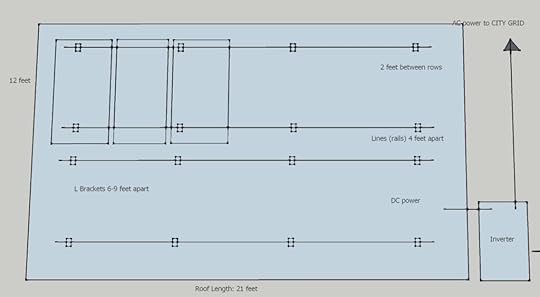
Laying out support brackets, rails, panels, and power inverter.
Important consideration: Because I was putting this on a garage roof (technically “unoccupied space”), I was able to squeeze them all the way to the roof edge. If you are installing on a house, your city’s fire code may require that you leave a 3 foot walking access around the edges. Sometimes it’s wise to think outside the box: a garage roof, a standalone ground-mounted rack if you have lots of unused land, or creating the new workshop/carport/garden shed you’ve always wanted in the sunniest part of your yard.
2: Install your Brackets and Rails
Once you figure out where to put the long “lines” shown above, you measure them out and snap chalk lines right over top of your existing roof material. Then, use some sturdy 2.5″ lag bolts and washers to hold down the L-shaped brackets that come with the solar racking kit. Pre-drill each hole, and inject in some “Through the Roof” sealant with a normal caulk gun before driving in those bolts – this creates a permanent watertight seal. (There are also special brackets to accommodate different roof styles like tile and metal).
Once the brackets are in, you simply use the supplied slide-in bolts and nuts to attach the long rails, straighten them up nicely, and lock it down. Doing all of this with a cordless impact driver makes it quick and clean.
3: Bolt down and connect the Optimizers if you’ve Got ‘Em
These are just little flat boxes that you connect to the top of each pair of rails, about 6″ from the eventual right edge of each solar panel. There’s one optimizer for each panel, and it acts like a babysitter – monitoring output from the panel, compensating for voltage changes when necessary (such as when shade hits that panel). You’ll notice that each optimizer has four wires protruding from it, and there’s one optimizer for each panel. This will make sense in the next step.
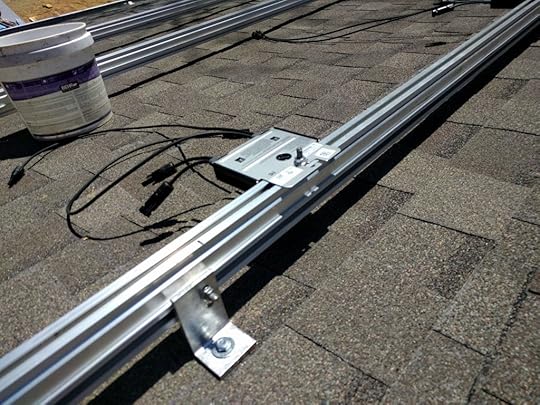
Optimizer mounting (face down), plus a good shot of the connections between roof, brackets, and rails.
Once all the optimizers are in place, you connect each pair of longer wires together with the incredibly convenient fast-click connectors. The positive and negative wires have differently shaped connectors so you can’t accidentally reverse them.
You end up connecting inverters to each other, and each panel only to its host inverter, like this:
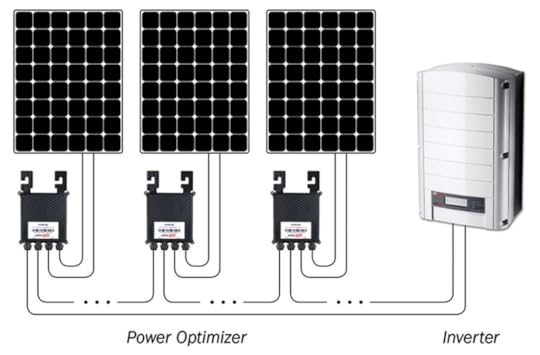
Inverter to panel connections
If you have two lines of panels as I do, connect the far end of one line to the far end of the next line, so you end up with a long series of optimizers where both ends terminate with a loose wire on the end closest to your inverter.
Grounding is Important: Using the supplied grounding screw terminals, connect all the rails together with bare 10AWG copper wire. From that last terminal, you’ll be running a length of the same size wire down to the inverter.
4: Install the Solar Panels!
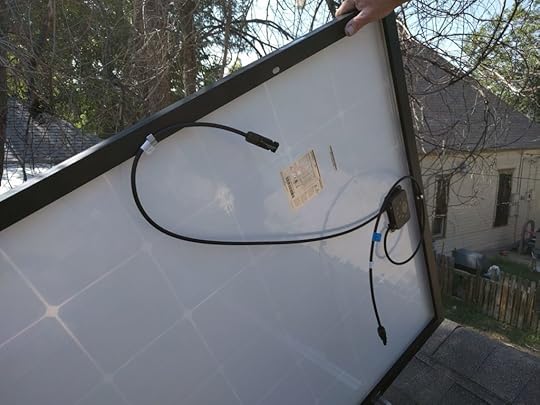
The bottom of each panel has two long output wires. Use clips and/or zip ties to keep the cables tidy so they don’t dangle onto the roof too much.
This step is better with two people, especially on a steep roof. Starting at the furthest corner from the location of your inverter, connect each the panel’s wires to the matching ones on its host inverter. Set the panels down straight, and use the click-in clamps that come with the racking system to clamp down the panel using your cordless drill/driver.
By the end of this step, you’ll have one or more tidy lines of panels with just two powerful-looking DC wires poking out the end, with connectors to go.
You’re now ready to build the final run of wire, which will enter a metal conduit and travel through your roof, down the side of your house, and into the inverter.
5: The Home Run:
Drill a 1″ hole in your roof and put a roof boot over top of it, tucked under the upper course of shingles. From there, your goal is to provide a protected path to get the high voltage DC wires to from the panels, down to the inverter.
My city required 3/4″ metal rigid conduit, which gave me the opportunity to learn about the various fittings and connectors that are part of working with conduit. I also bought a conduit bending tool, since there are many more outdoor electrical projects still on the docket for the MMM HQ building.
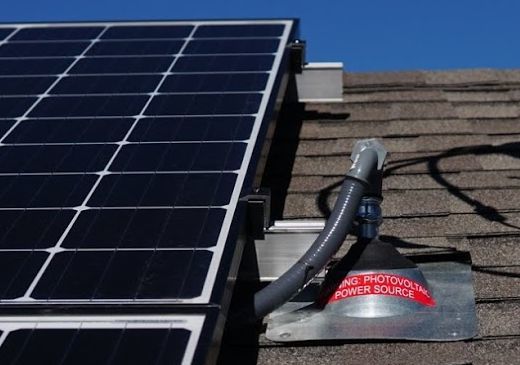
I ran a length of metal conduit up from the inverter and just beyond the roof boot, then transitioned to a downward-facing connector to some flexible conduit, just to keep the wires covered until they get under the panels. All three conductors including the ground are running through this tube. If doing it again, I’d suggest using a different conduit box for that transition. Also, you can switch from a bare ground wire to a stranded, insulated ground at that point – much easier to pull through!
6: Mounting The Inverter and Connecting it all to the Grid:
The part that sounds the most mysterious is actually one of the most simple:
Hang the inverter on the wall using the supplied bracket and a few screws
Connect the conduit and pull in the DC wires from the solar panels into the inverter’s connection box. On this Solaredge unit, there are nice spring clip terminals.
Do the same on the other side of the connection box, running a length of 10/3 household wiring (for outputs up to 40 amps) right into the breaker box, as if you were hooking up any other 240 volt circuit.

Inverter mounting, including the conduit going up through the roof (left), out to the main breaker box (right), required warning stickers (red), and how it’s hooked up inside (bottom)
7: Get it all Inspected and Power it Up!
The inspector will probably have a nitpick or two with your work. Stay strong and make any required corrections, and pass that inspection. Then you flip on the AC breaker, the DC power switch, the inverter’s main power switch, and poke through the menu systems to make sure everything is set to run the way you like it.
For this Solaredge system, I had to run a “Pairing” step with the power optimizers (see manual), and add a TP-Link Wireless Repeater/Bridge to allow the inverter’s wired Ethernet connection to join my existing property-wide Wi-Fi network. Which happens to be the the spectacularly good Google Mesh Wi-fi system.
So What’s Next?
From this point on, it’s all on automatic pilot. The system generates electricity every day, which reduces the Headquarters power bill down to zero. In winter, the days are shorter so we might consume more than we produce. But in summer, a large surplus will more than make up for it.
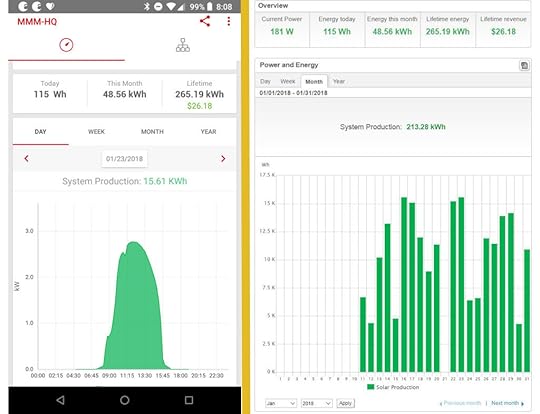
My inverter from Solaredge comes with a really nice monitoring features, available from both a phone app and any browser. Plus, you can share a public version of your page with anyone. Here’s one I made for .
At the time of writing, I’ve had the system online for 27 mostly-January days, including a couple of writeoffs where the panels were covered in snow. It has still averaged about 10 kWh of electricity production per day, which is more than the average consumption of the whole facility. Put another way, the 265 kWh of electricity is enough to power an electric car for roughly 1000 miles of driving.
The monitoring tool also estimates about 410 lbs of CO2 emissions prevented, which is 0.2 tons or about $4.00 worth at current carbon cleanup rates. If you happen to care about running a carbon-neutral life (or business) as I do, this means the carbon offset makes your solar electricity about 15% more valuable in your mental accounting.
I can also double or triple the number of panels on this particular system (once I decide on a good place to put them) without changing the inverter or any of the grid-tie connections, which will greatly improve my annual return on investment. It’s just a LEGO-like plug and play to connect more panels to an existing rack of them, plus the inverter has a second set of inputs if you are running in some wires from a string of panels you have placed somewhere else.
My power company pays out a check for any overall surplus at the end of each year, purchasing the power at a wholesale rate. But many regions are more solar-friendly than this, giving you a full retail or even higher rate for solar-generated electricity as an incentive to go green.
The Final Word:
Solar energy is strangely fun to produce – most people report satisfaction far beyond just the monetary benefits. It gets you out there rooting for the Sun, and for your fellow humankind to follow suit and start harvesting it alongside you. So if you’ve been considering getting it done, the time is good.
Thanks again to John Shaw (shawsolar.com) for all the help with this project. If you have questions about the details or the industry in general, please put them in the comments and both John and I should be able to weigh in.
And if you happen to own a home or business around Durango, CO, contact Shaw Solar directly and tell ’em who sent you!
Rough Edges Alert: I’ve started by publishing this article in an unpolished form, so If you see incorrect details, please let me know and I’ll clean it up over time after publication.





January 22, 2018
An Interview with Matt Cutts: Can the Government grow a Money Mustache?
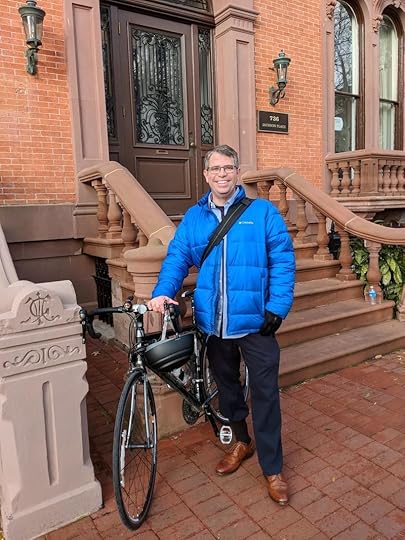
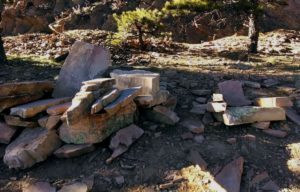 One day last week, the icy grip of a winter storm broke and the skies of Colorado returned to their normal state of deep blue with bright sunshine. So I decided to head out for a hike on the warm red rock trails just outside of Boulder.
One day last week, the icy grip of a winter storm broke and the skies of Colorado returned to their normal state of deep blue with bright sunshine. So I decided to head out for a hike on the warm red rock trails just outside of Boulder.
Taking a break on a big rock at the summit of the mountain, I pulled out a snack and a tiny glass-encased computer from my backpack. I unlocked it with my fingerprint and casually learned a few things, shared a few ideas, and conducted a few thousand dollars of business before the bag of carrots was done, then snapped a twelve-megapixel image or two before pressing the lock button and tossing the phone back into my pocket.
I took a brief moment to marvel at the efficiency of this whole situation, and how much wealth it brings to people like you and me who are privileged and clever enough to get set it up in our lives.
Efficiency reduces waste and multiplies your productivity, and even a small helping of it is enough to tilt you into a lifetime of financial surplus. Yet it is so rare that most people in the richest countries spend most of their lives in debt.
This contrast was illustrated dramatically as I descended from that Millionaire’s Rock and returned to reality. I needed to renew my driver’s license, so I stopped at the Department of Motor Vehicles only to find a two-hour lineup of people, waiting to speak to an understaffed roster of tired employees, manually entering information that was already duplicated on countless other government servers, into their own antique computers. And this was obviously not a new problem: I could see signs that a construction project was underway – the waiting room was being doubled in size to allow more people to sit and wait.
 “THIS”, I thought, “is why so many people hate the government. Here we are spending taxpayer money on more drywall and willingly wasting my time, instead of figuring out the root of the problem, which is that I should have been able to renew my driver’s license with a smartphone app, at least any time after the year 2010.”
“THIS”, I thought, “is why so many people hate the government. Here we are spending taxpayer money on more drywall and willingly wasting my time, instead of figuring out the root of the problem, which is that I should have been able to renew my driver’s license with a smartphone app, at least any time after the year 2010.”
And I have similar stories about paying my city utility bills, applying for building permits, handling payroll taxes, and legally immigrating to this country in the first place. We need these public services, but we’d all be much wealthier if they worked more efficiently.
Why does this happen? Why is almost everything from Silicon Valley shiny and efficient, and almost everything from Washington DC (or the local government office) crusty and outdated?
In a word: Humans. When we work in big groups, we grow less efficient. When our groups have been around too long, we get even worse. When the management structure is too messed up, nobody is willing to take risks.
And most importantly of all, the most effective workers know all of this, so they avoid seeking jobs where they’ll be stuck in a crusty work environment.
In other words, truly talented tech workers rarely apply for government work, reinforcing a circle of inefficient services for citizens, and a low public opinion of government efficiency. Is there a way to fix this?
Enter Matt Cutts and the US Digital Service
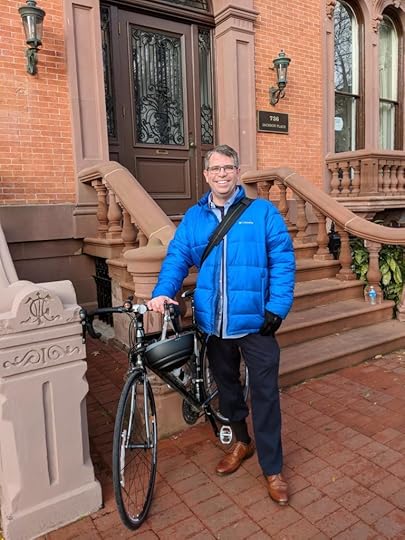
Matt Cutts arrives in central DC, after a midwinter morning’s bike commute to work.
Luckily, this self-reinforcing problem was not lost on the world, and some people have been trying to crack it.
Imagine, for example, if we could take one of the core developers of the Google search engine (one of the most efficient pieces of software in the world’s history), and get him to leave the lucrative tech industry to help the ailing public sector?
Matt Cutts is famous enough in the software world that he has his own family of followers known as ‘cutlets’. The Wall Street Journal stated in 2009 that ‘Cutts is to search results as Alan Greenspan is to interest rates’. And some of his efforts leading the Webspam and SafeSearch teams are the reason you can get useful Google search results instead of the monetized junk that is always trying to game the system and collect your clicks.
Then, imagine you could pull in a bunch of other top-tier developers and designers, empower them in Washington, and put them to work solving some of the nastiest efficiency problems?
It would be a tough job, but it would also be some of the biggest bang for the buck you could ever achieve, because all the fruit is juicy and hanging very low from the trees.
In Silicon Valley, you might compete to shave a dollar off the cost of app-powered flower delivery for a few thousand high-income families. In the federal government, you can change the lives of hundreds of millions of people whose lives are affected by government services.
Veterans applying for medical help, people applying for visas, businesses trying to win contracts or comply with regulations. Doctors trying to finish Medicare paperwork so they can spend more time with patients. And the Department of Defense gaining better security, to avoid having their information (or their nuclear launch codes) pickpocketed by hackers from more nimble organizations.
So, this has actually started happening.
In 2014, a critical mass of tech-savvy people in the White House were able to form something called the US Digital Service and begin looking for talent. They began to form a nimble start-up company within the government, with more autonomy and less bureaucracy holding it back.
In 2016, they found a willing recruit in Matt Cutts, which is around the same time I met him*
After kicking around the idea for a few years as I watched some of the progress via his Twitter account, we finally decided to do this interview. So let’s get into it!
Matt Cutts and the US Digital Service
MMM: How did the idea of the US Digital Service get started? Was it directly from Obama’s staff contacting you, or someone from the tech industry looking East?
MC: The US Digital Service got its start from a pretty big disaster: when the healthcare.gov website failed back in 2013. Regardless of whether you’re conservative or liberal, it’s pretty wild to see a signature presidential initiative at risk because the enrollment website didn’t work well. Todd Park, who was the CTO of America — how cool of a job title is that — recruited a small cadre of tech folks to help the website hobble over the finish line. Within a few months after that success, the government stood up the Digital Service to help on other technology projects throughout the government.
MMM: When I hear the word “Digital Service”, it has some echoes of both Secret Service and the military, like you sign up to be one of The Troops. Do you see parallels (and major differences) between enlisting for military?
MC: Absolutely. One parallel is the Digital Service asks people for a limited tour of duty. Most people end up staying for over a year but less than two years. We also try to set the expectation that like all jobs, some days are harder than others and can be really challenging. The idea is that we promise to find high-impact projects that will benefit others when you bring your expertise to government.
That can mean working in stressful situations where things aren’t going well. Your readers know how important it is to stretch ourselves to learn in new situations though, and how meaningful it can be to align our mission in life with our beliefs**. And of course, one huge difference is that no one in the Digital Service is put in harm’s way like the military or Secret Service.
So the work is demanding, but it’s nowhere near as hard as the military. We’re still sitting indoors while talking to people or tapping on keyboards.
MMM: How do the pay, benefits and work environment compare between USDS and private industry? What about living expenses in the area. Any perks or career advantages you perceive to working there?
MC: It’s a misconception that you have to take a huge pay cut. USDS can pay up to the maximum government “General Schedule” salary, depending on previous experience and salary. That can mean around $160,000/year. We ask people to move to Washington, DC, which is an expensive place to live, but it also has great public transit. You really don’t need a car in DC and it’s possible to live close to where you work.
I usually ride my bike to work and get a free workout each day. I will note that when working for government, you don’t always get to use all the latest cloud-based productivity tools that you can access in a startup, but that depends on which agency you’re working with.
MMM: What major things has the Digital Service accomplished so far? Do you have an estimate for how many people are affected and how many dollars (and hours) have been saved, versus the amount spent on the program?
MC: Oh man, I could talk about the work we’ve done for a long time. Sometimes it’s bringing time-tested industry best practices into the government. Take bug bounties, for example. The idea of offering money to researchers who find security holes has been used since 1995 on Netscape. But the Federal government had never done a bug bounty before. Our team at the Pentagon has run 7-8 bug bounties with great results: the government is more protected, and bug bounties can be cheaper than other ways of finding security holes.
Here are a few additional accomplishments:
Launched vets.gov, which is a one-stop shop for Veterans to discover, apply for, manage, and track their benefits. It’s a much better experience to (say) apply for health benefits with a web form instead of proprietary/bad tech.
Built a new system to help doctors understand and manage what they report to Medicare.
Streamlined the process for small businesses to be certified for government contracts.
Launch an online self-service option for checking online visa status, which saved thousands of calls.
Accelerated naturalization applications so that they’re 50% digital instead of 5% digital.
Helped create a better system that helps military families relocate.
Helped fix security issues at the IRS and OPM, helped students figure out which college is the best fit for them, and built login systems that the rest of the government can use.
These are just a few projects we’ve done. If you want more nitty gritty details, check out our multiple reports to Congress. Or if anyone wants to apply to the US Digital Service, we’d be more than happy to talk about projects in more depth.
With a modest budget, we’ve helped tens of millions of people across the US. A pretty conservative estimate is hundreds of millions of dollars saved. Plenty of labor hours have been saved, too. When a computer can check that all the documents for an application are attached and complete, for example, that saves manual checking, not to mention time (and postage) mailing paper back and forth.
MMM: When working on complex software projects in a big company, I found the hardest part was often the beginning – after you have a foundation you can work off the same pattern, your reputation grows and your progress grows exponentially. Do you see this happening in your work so far?
MC: It really varies based on the situation. When there’s a crisis, we can move quickly. Other times, an agency does need to see that you’re committed over time. Lots of people in the government show up promising to help and then don’t deliver. So we start off small, building trust and credibility.
One example was veterans’ disability claims. The people judging those claims had to download dozens of documents one at a time. So we built a “download all” button for them. It wasn’t hard technologically, but it solved an actual problem. It showed that we were listening to their issues and were serious about helping. From there, we were able to build up a relationship with partners and stakeholders. In fact, we just passed 100,000 Veterans whose appeals happened a little better or faster because of tools that we built.
MMM: From the outside, I have imagined that many of the government’s priorities turned over after the 2016 election – Have you noticed a change from the inside, or do you feel your work remains prioritized and valued?
MC: Practically everybody agrees that we need government services to be more modern. Did you know that the government runs some technology systems that are over 50 years old? This still amazes me. Improving technology is one of the few ways where a service can get better and still cost less. Our work is nonpartisan, and we still get to work on important projects that matter to the public.
Earlier this week I got to have breakfast with members of Congress from both sides of the aisle, and it’s remarkable how much common ground there is on improving technology so the government works better for people.
MMM: There’s another group called Code for America that has a similar-sounding mission to the layperson. Could you explain the difference between CfA and USDS?
MC: Code for America is a great group of folks! They’re a non-profit that works primarily with state and local governments to improve their technology. The US Digital Service is a part of the Federal government, so we tackle programs at a national level. It turns out that the civic tech space is pretty small in some ways, so it’s still possible to get to know a lot of people who have an outsized impact on technology in government. Code for America is one of the organizations that got me interested in civic technology in the first place.
MMM: Has financial independence played a role in your willingness to do this job?
MC: No one needs to be financial independent to work for the USDS–we pay solid salaries–but my previous career as a software engineer did give me the freedom to work on what I want. But you’ve made the point over and over that financial independence doesn’t automatically mean that you stop working–it means that you work on what you want to work on. At the US Digital Service, I get to work with amazing people who are tackling projects that really matter.
MMM: Should readers of this interview apply to the USDS? If we wanted to filter to exactly the right candidates, how would we do it?
MC: Yes, they should apply! We’re always looking for mid-career software engineers, site reliability engineers, product managers, and designers–people who have accumulated some real-world experience and maybe a few scars. If you can stand up a major web service, for example, that’s a plus. We also look for folks with emotional intelligence and the ability to tell the truth in hard situations. You may need to sit down with a cabinet secretary and break the news that their new product isn’t ready to launch yet.
MMM: How else can they support you?
MC: If your readers are not ready to apply themselves, maybe they know a good software engineer and will encourage them to apply? Also feel free to share this interview with them or elsewhere on social media. :) It’s important to know that there’s a third path open to technologists now besides academia and industry. And it’s possible to find jobs that are meaningful even if they can also be hard. Keep looking until you find one that’s right for you. Lastly, you can follow USDS on Twitter and on Medium.
MMM: Thanks for your time Matt, and thanks for taking the time to help out in the world. This article is part of an ongoing series of “Interviews with Interesting Mustachians”, and there are quite a few in the queue for this year. To a prosperous 2018!
And if you have questions for Matt and the USDS team, feel free to write them up in the comments. I’ll invite them to participate in the discussion.
* I first heard about Matt when he sent me a random PayPal donation in 2015. It was a shock:in a long-ago article in the very early days of this blog, I had put a donation box in an article with a comment like “Hey, you can keep reading for free, but if you insist on sending me money, here’s the way to do it.” He shocked me by sending $100.00, so I looked up his biography and sent him a thank-you email. Later, he enticed me into attending an underground conference called “Foo Camp,” which involved spending a weekend camping out with 200 young Silicon Valley tech titans and giving impromptu talks to each other. I gave a talk on Mustachianism, and answered questions from a guy at dinner about index fund investing. Later, someone pointed out that it was sci-fi legend Hugh Howey, and both my son and I have since gone on to read most of his books.
** Matt and I did this interview by collaborating in a Google(of course) Doc, which means he was able to add his own links. So, all the links within are by him. I noticed that some of them, like this one, link to old MMM articles. I was impressed by his deep and historic knowledge of Mustachianism. ;-)





Mr. Money Mustache's Blog
- Mr. Money Mustache's profile
- 60 followers


